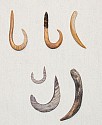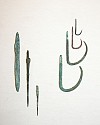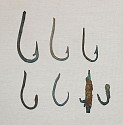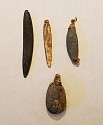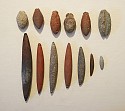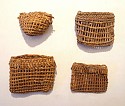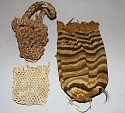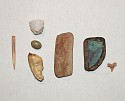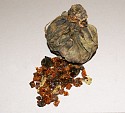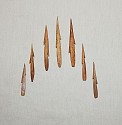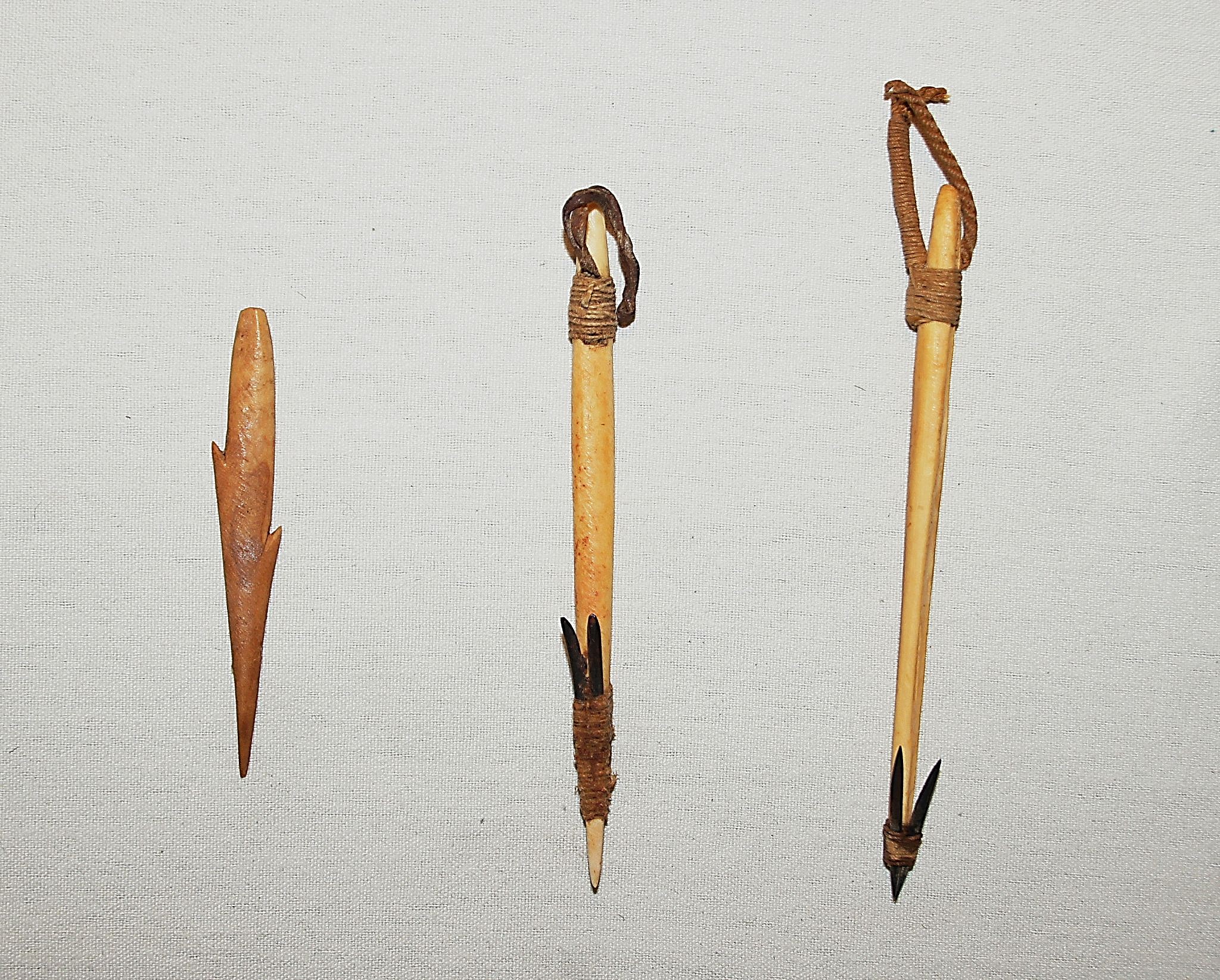


Chile, Harpoon Forepoints of Bone, with Thorn Barbs
The harpoon points were for small fish. They had a gut loop at the end to attach a recovery line.
Period: Chile, Arica, formative period, c. 1000 BC - AD 300
Media: Bone
Dimensions: Length: 3â€, 4.5â€, 5.5â€
Price Upon Request
N6019
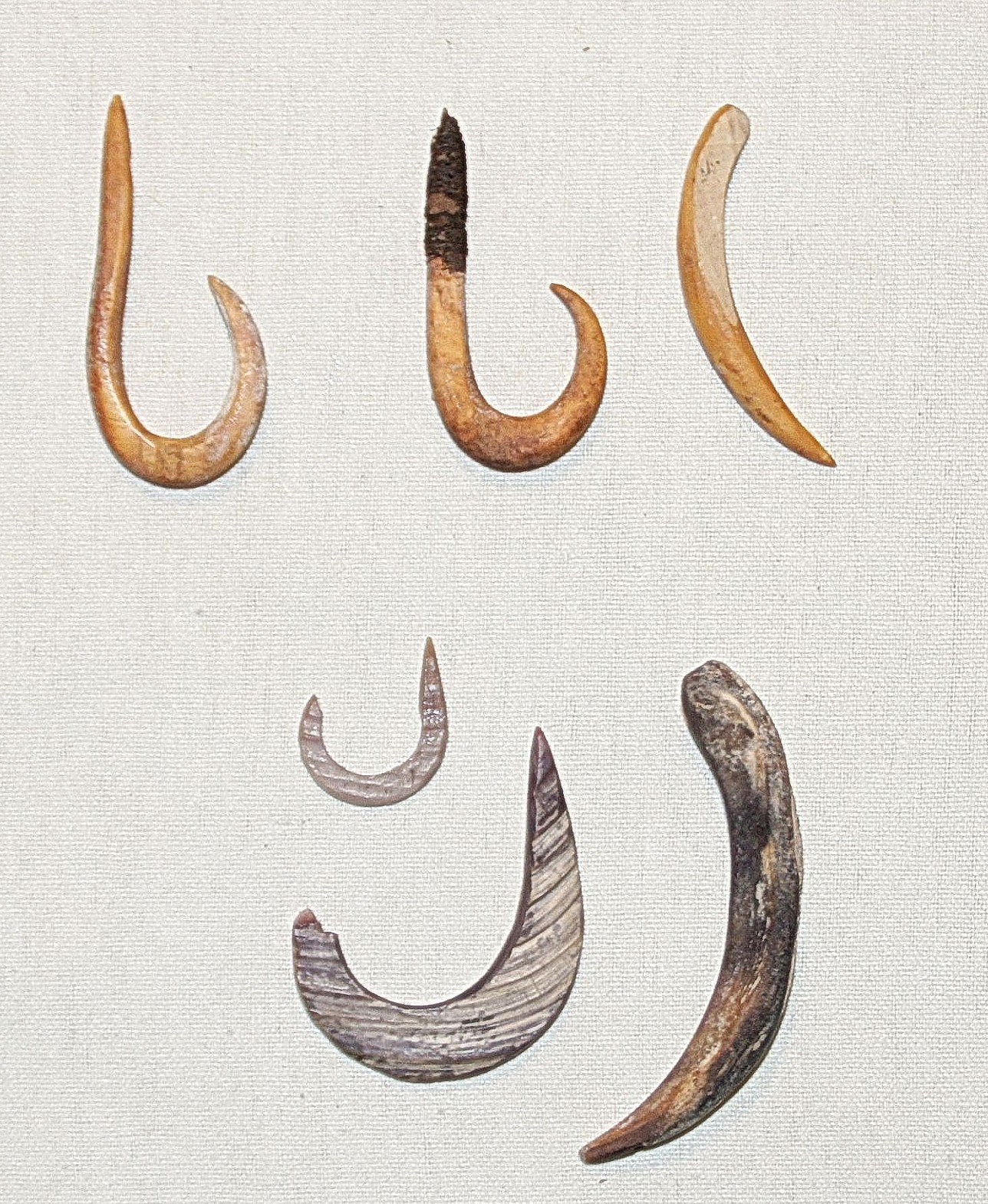
Chile, 7 Early Bone and Shell Hooks
This collection includes four bone hooks, one of which was attached to a stone sinker as a barb, and three early spondylus shell fish hooks. The shell fishhooks were made from clam or Spondylus shells by drilling a hole and then carving a hook shape from the outer edge of the hole.
To view an illustrated discussion of the fishing methods and implements of ancient Chile, along with a catalog of the collection in PDF form, PLEASE CLICK HERE.
Period: Haiti, Courian Subseries, c. 2000 BC - AD 250
Media: Shell
Dimensions: Lengths vary: .75†– 3â€
N6017
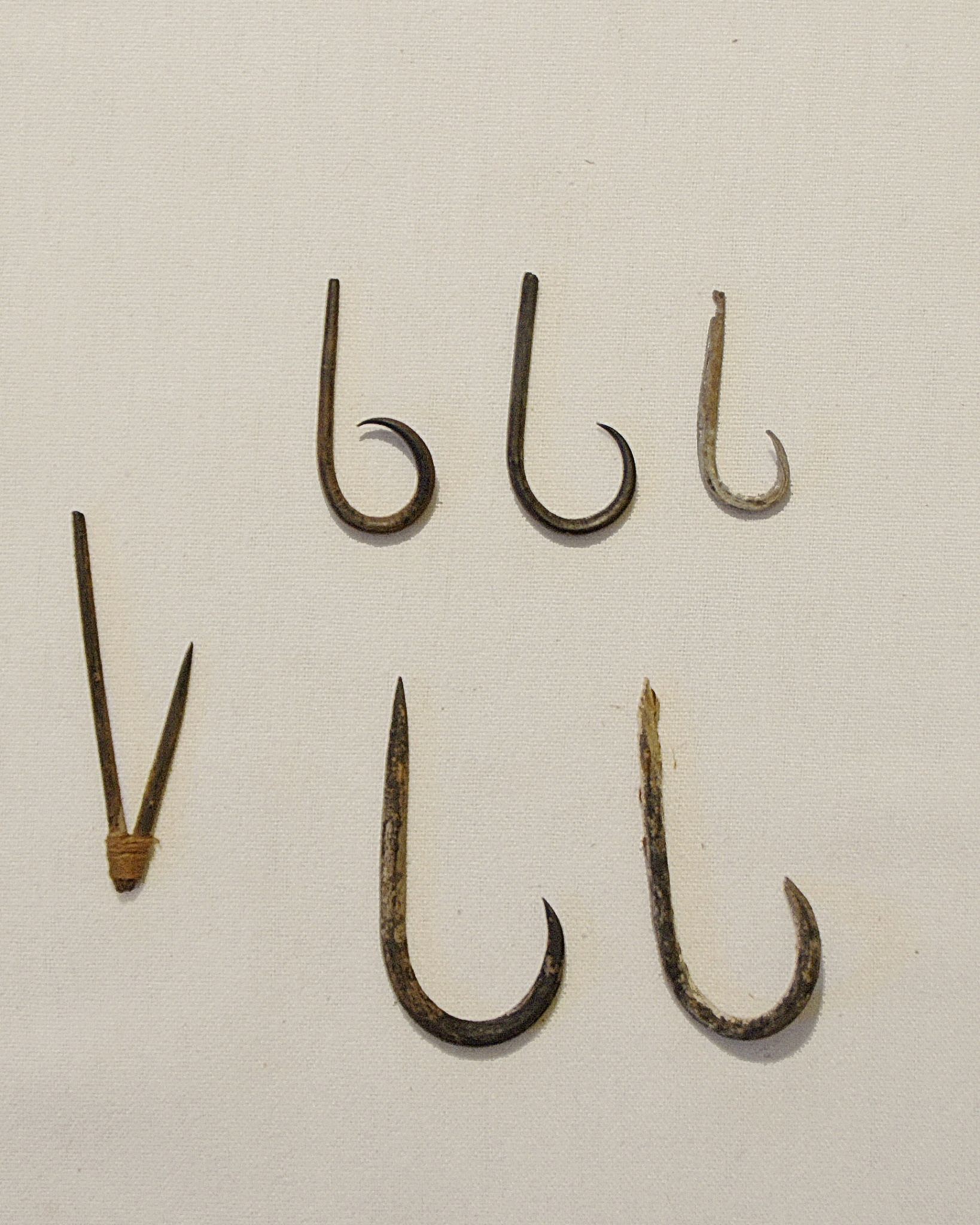



Chile, Six Cactus Thorn Fish Hooks
The thorns were curved with heat and the points were occasionally sharpened with a flat stone. These hooks each have a notch at the opposite end to secure cotton line. The two-part hook was an earlier development before the curved hook was invented.
Period: Chile, Camaroni, North Coast, c. 100 - 600 BC
Media: Wood
Dimensions: Lengths Vary: 1"- 2"
n6033
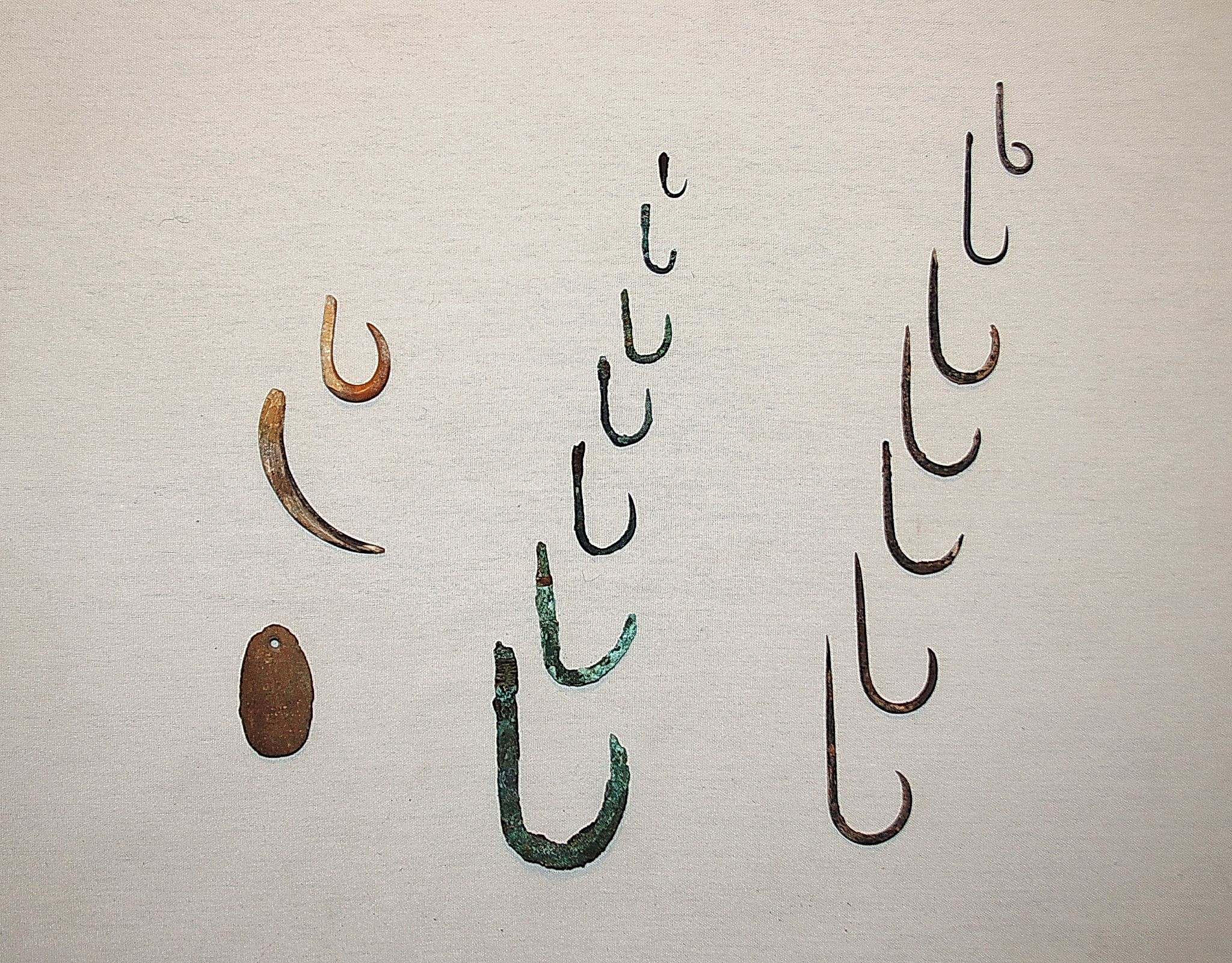
Chile, Early Fish Hooks Made of Shell, Copper and CatusThorn in Varying Sizes
These shell hooks are the most early and rare form of Pre-Colombian fish hook. The copper hooks with straight shanks still have the original cotton line, which has been corroded. The thorn hooks with straight shanks have a notch to secure a fishing line. The flat stone with a suspension hole was for sharpening the fishhook's points.
Period: Chile, Arica, formative period, c. 1000 BC - AD 300
Media: Metal
Dimensions: Lengths vary: 1" - 2.75â€
N6016
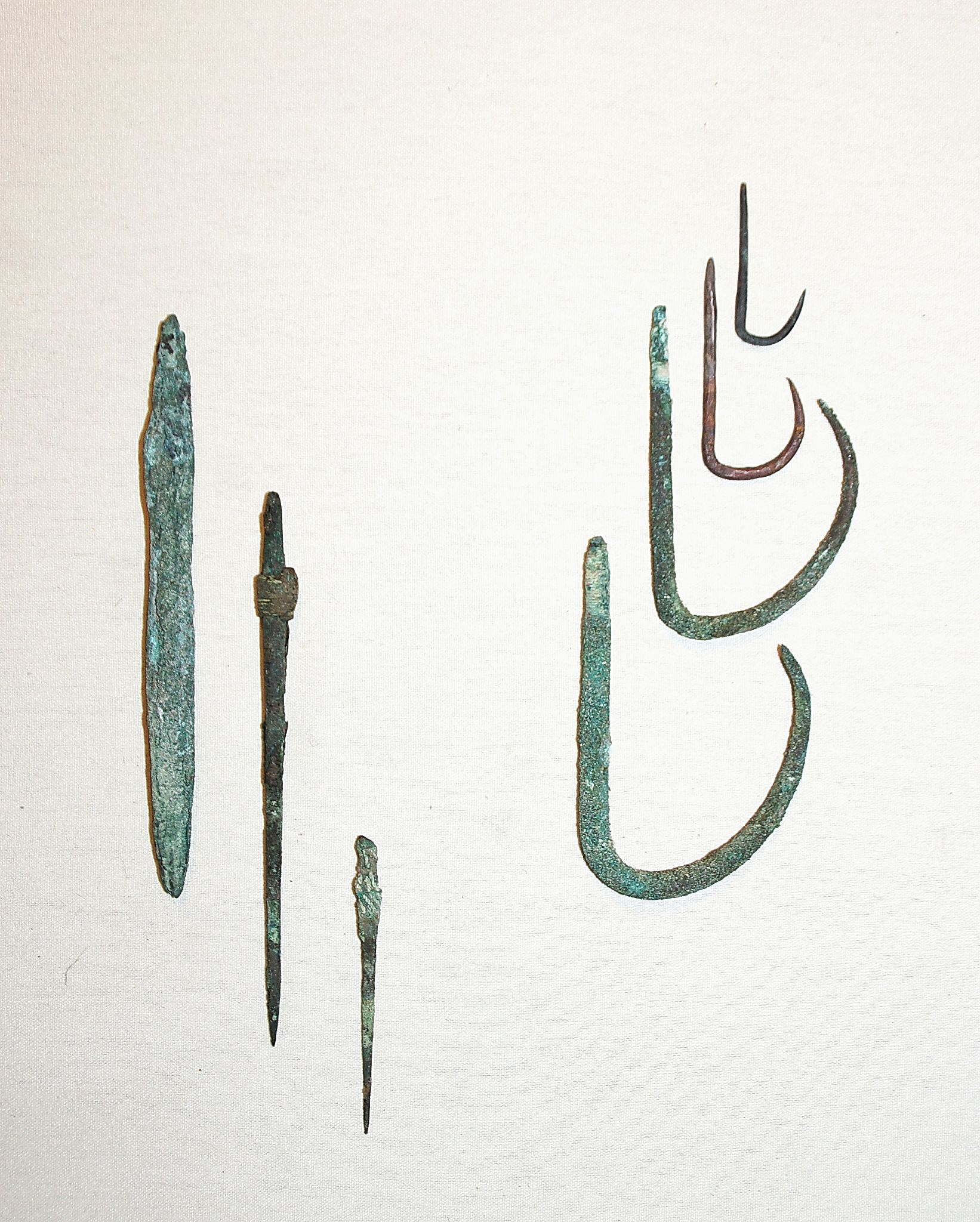
Chile, Copper Spear Tips and Fish Hooks
These copper spear points have traces of the original cotton line . The sharp points were fitted into a slender wooden shaft in order to spear small fish. The large copper fishhooks are for large mouthed fish.
Period: Chile, Arica, formative period, c. 1000 BC - AD 300
Media: Metal
Dimensions: Lengths Vary: 1.5†- 5.5â€
N6018
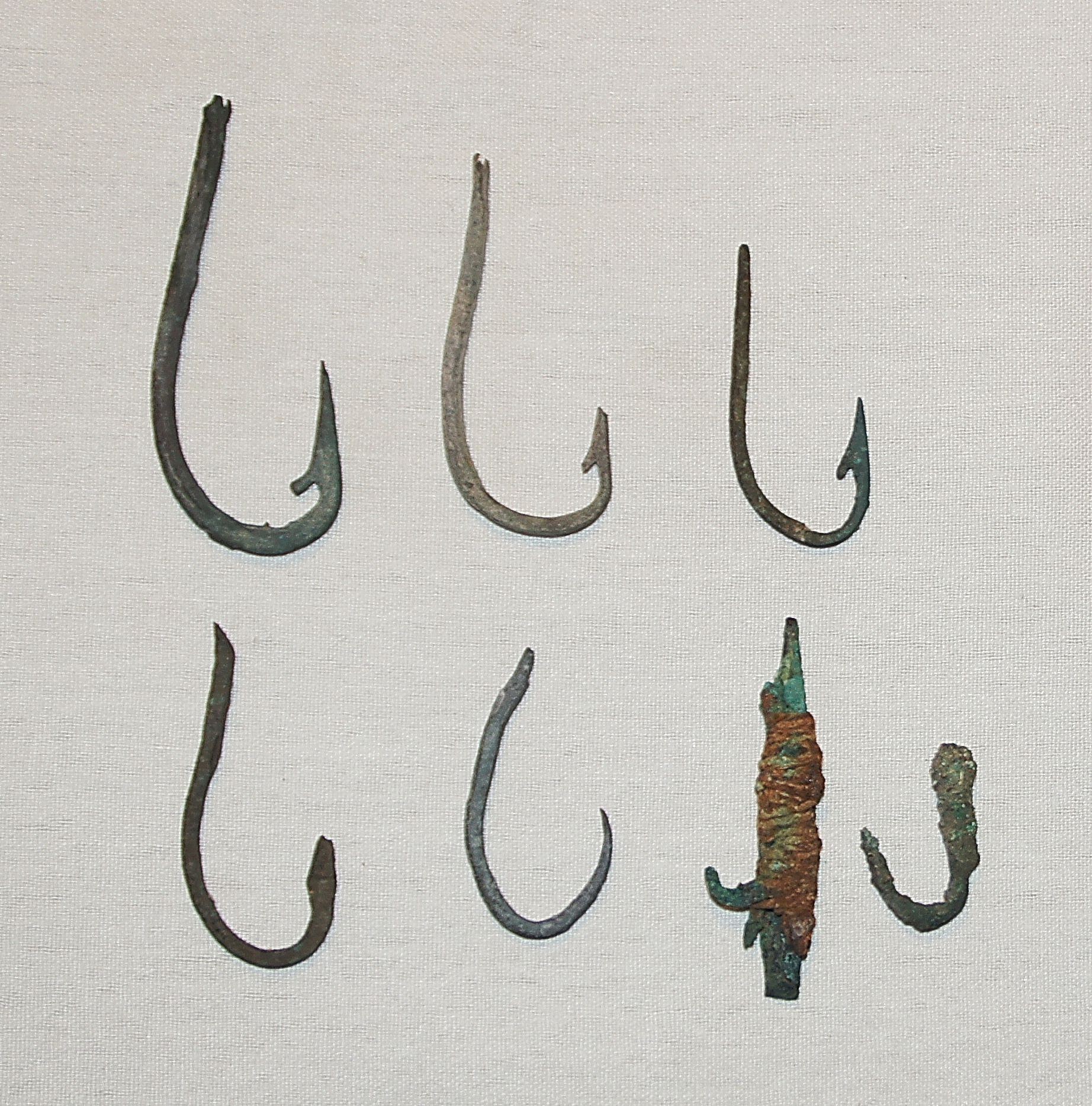


Chile, Late Copper Fish Hooks with Barbs
These barbs were made by hammering and chiseling the copper hooks. One hook demonstrates how a line was attached to the hook by tying a copper strip around the shaft so it would not slide off.
Period: Chile, Arica, formative period, c. 1000 BC - AD 300
Media: Metal
Dimensions: Lengths Vary: 1.50" - 2.5â€
N6024
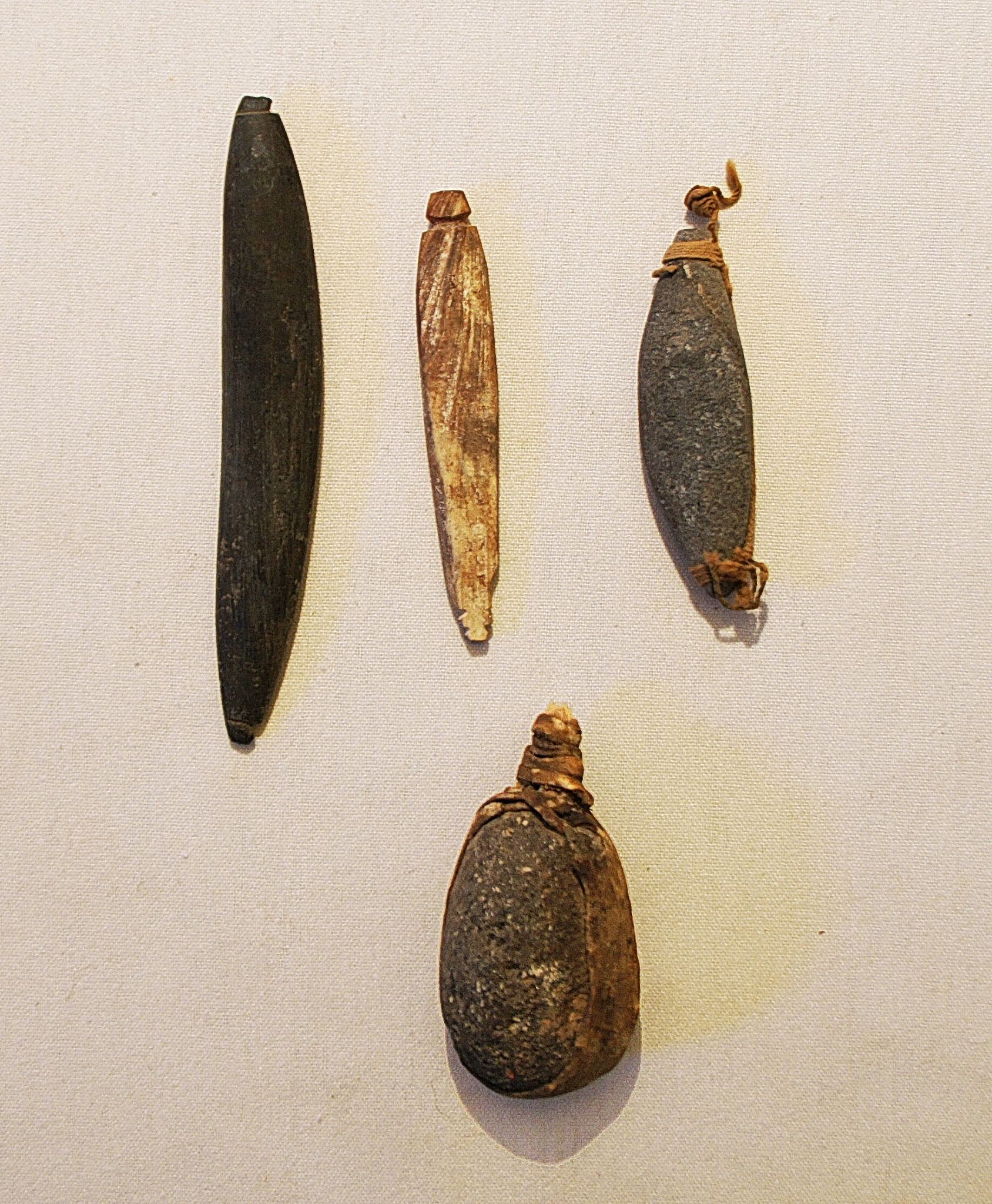



Chile, Four Fishing Sinkers With Attachments
This kit includes: one long stone sinker with a notch at each end, one bone sinker with a notch at each end, one stone sinker with the original cotton cord at each end, and one bulbous stone sinker with the original gut wrapping intact.
Period: Chile, Arica, Far North Coast, c. AD 900 - 1200
Media: Stone
Dimensions: Lengths vary: 1.25" - 2.5"
n6036
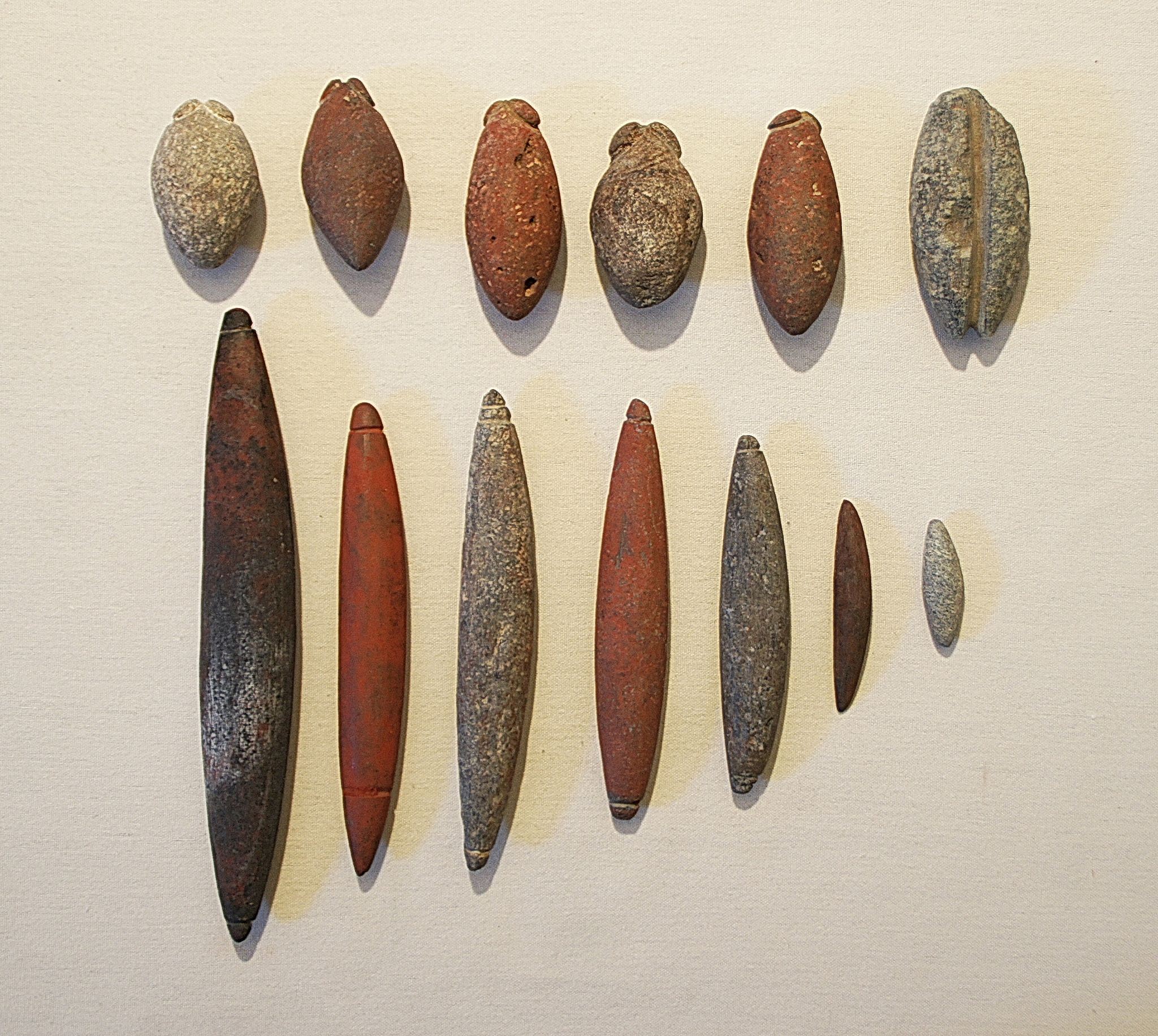




Chile, Thirteen Varied Stone Sinkers
Each sinker has notches at the end to attach to a line. Different sizes are for different size fish.
Media: Stone
Dimensions: Bulbous sinkers: 1.75" - 3" L
Oblong sinkers: 1.5"-7" L
n6037
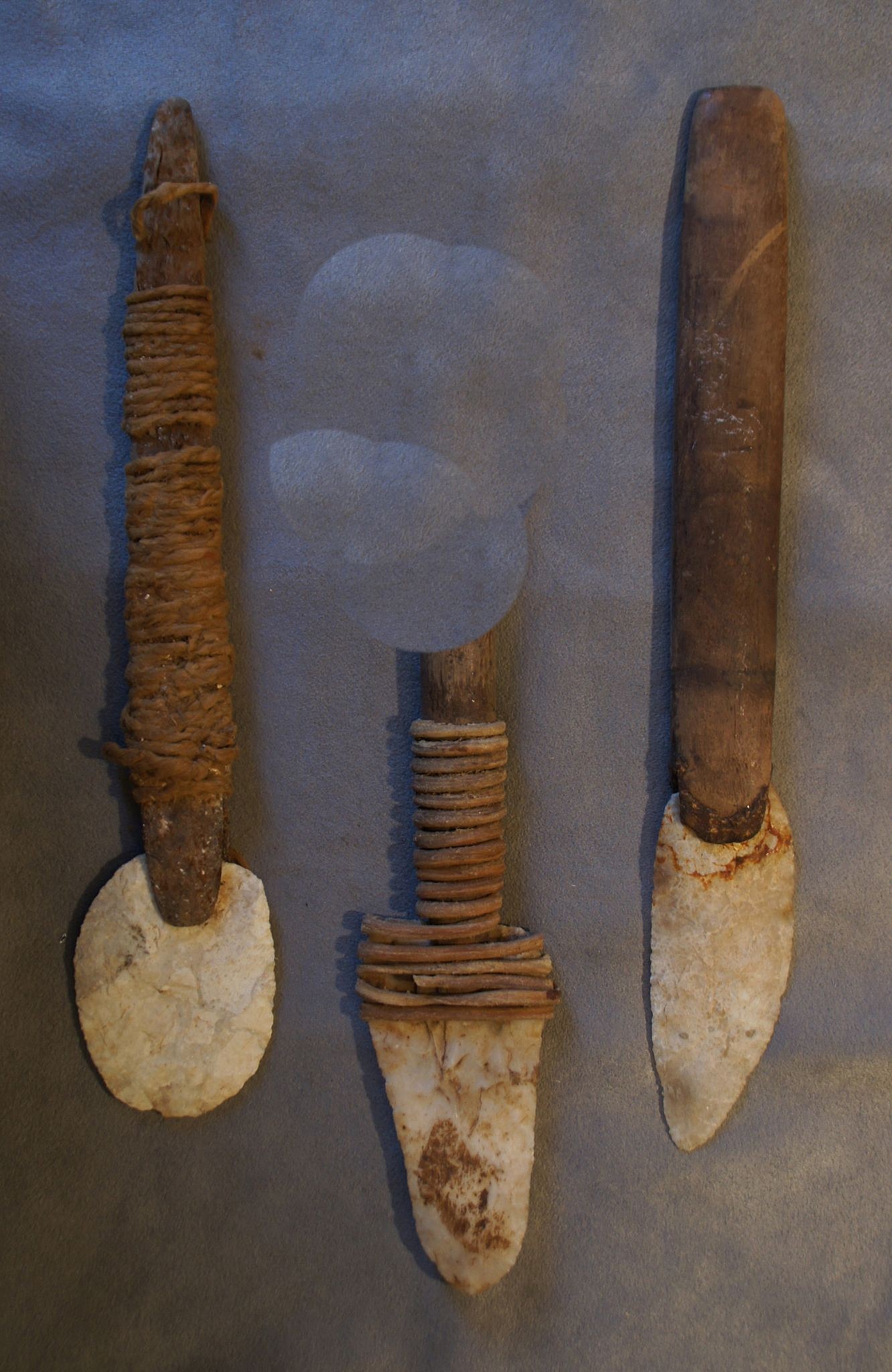
Chile, Three Claming Tools With Napped Broad Points
These tools were used to find and pry open clams and mussels on the sandy shoreline. Hemp or leather secured the points to slits in the wooden shafts. Traces of glue indicates that they used tree resin to secure the points in the shafts.
Period: Chile, Arica, Far North Coast, c. AD 900 - 1200
Media: Wood
Dimensions: Length: 9" each.
n6030
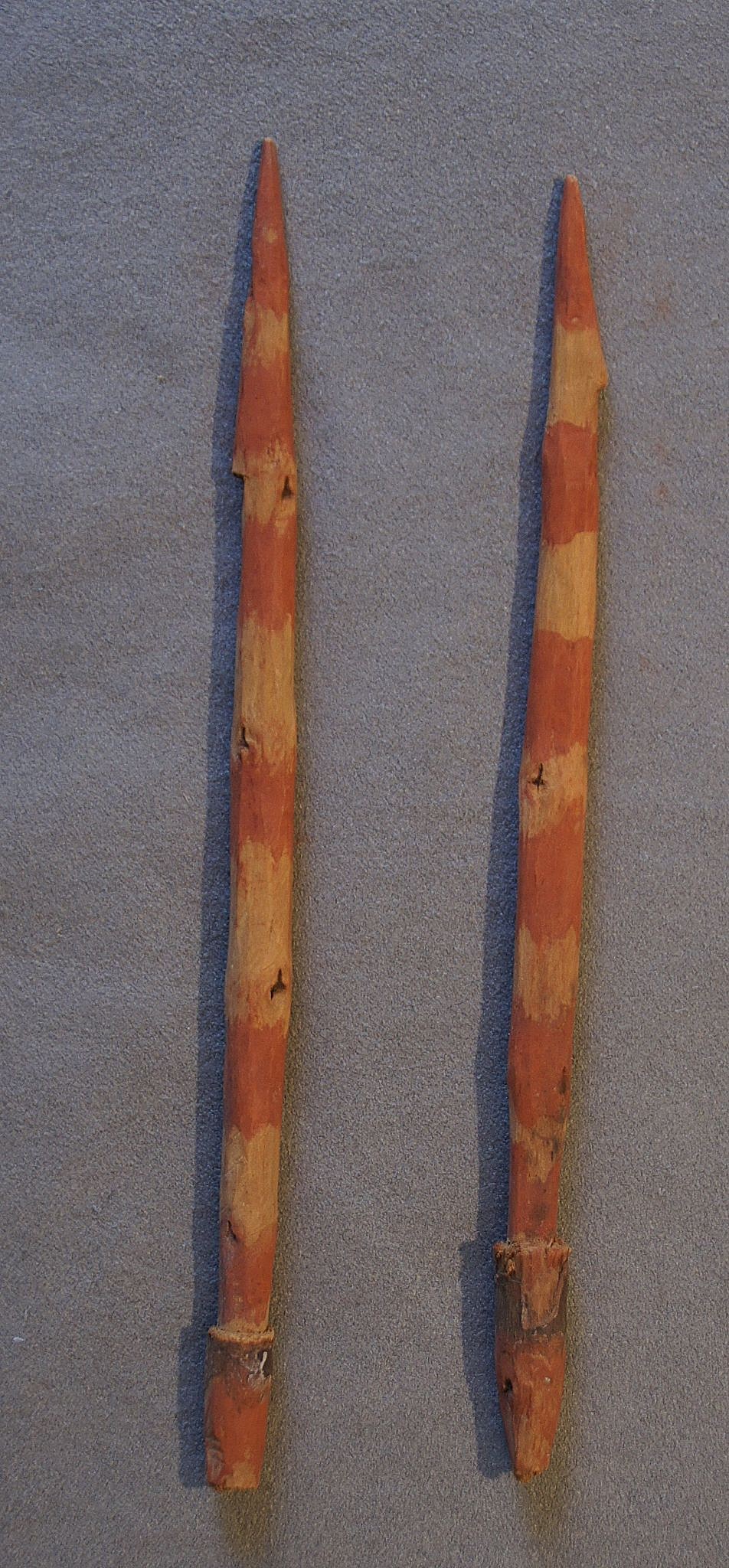



Chile, Two Early Carved Wooden Harpoon Points Painted with Red Stripes
These solid harpoon points are carved with a pointed tip and a notch to serve as a barb. The opposite end is tapered to fit into a socketed throwing stick. The red paint was usually used for items that were intended for use in the afterlife.
Period: Chile, Camaroni, North Coast, c. 100 - 600 BC
Media: Wood
Dimensions: Length: 7"
n6029
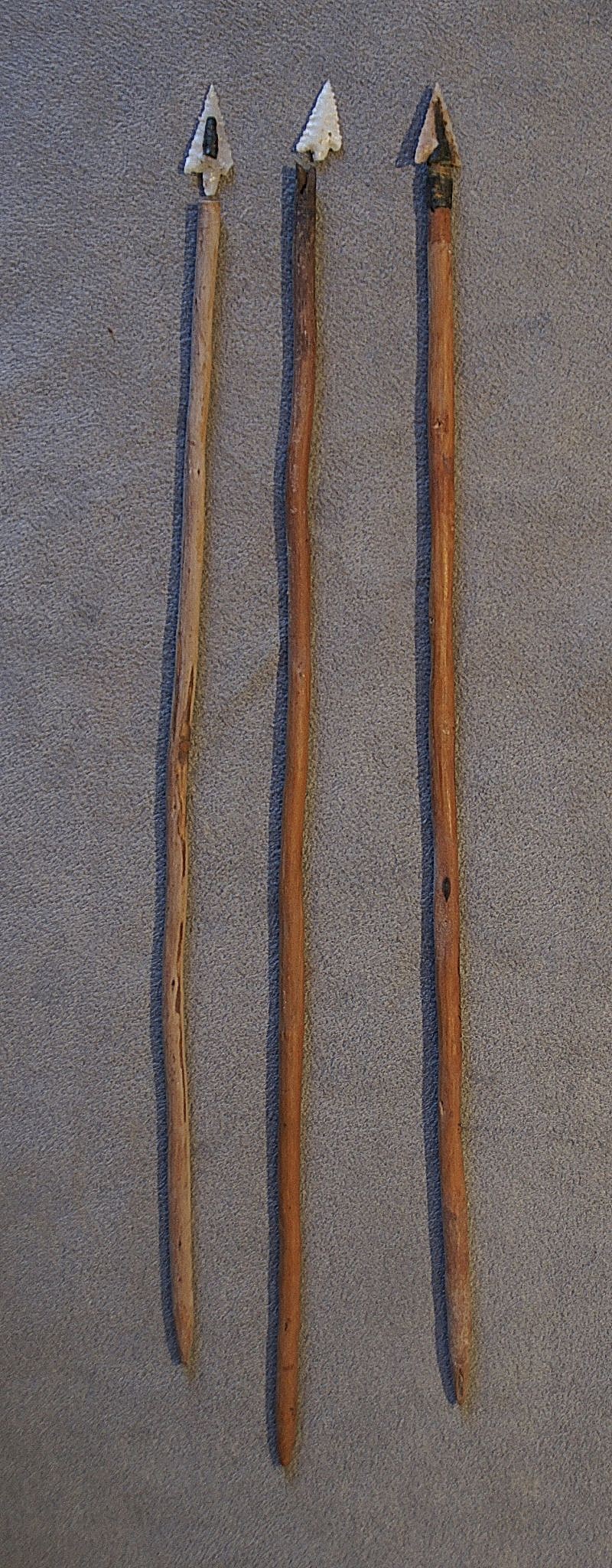



Chile, Three Arrows with Wood Shafts and Napped Quartz Points
These long, tapered arrows had small points for hunting birds and small fish. The points were inserted into a socket, then tied and glued to the shafts with black tree resin.
Period: Chile, Arica, San Miguel Phase, AD 1100 - 1200
Media: Wood
Dimensions: Length: 10"
n6031




Chile, Arrow with Quartz Point and Feather Fletching
The arrow is made from a thin wood shaft with a socket for the arrowhead and a feather for the fletching.
Period: Chile, Arica, Far North Coast, c. AD 900 - 1200
Media: Wood
Dimensions: Length: 10"
n6034
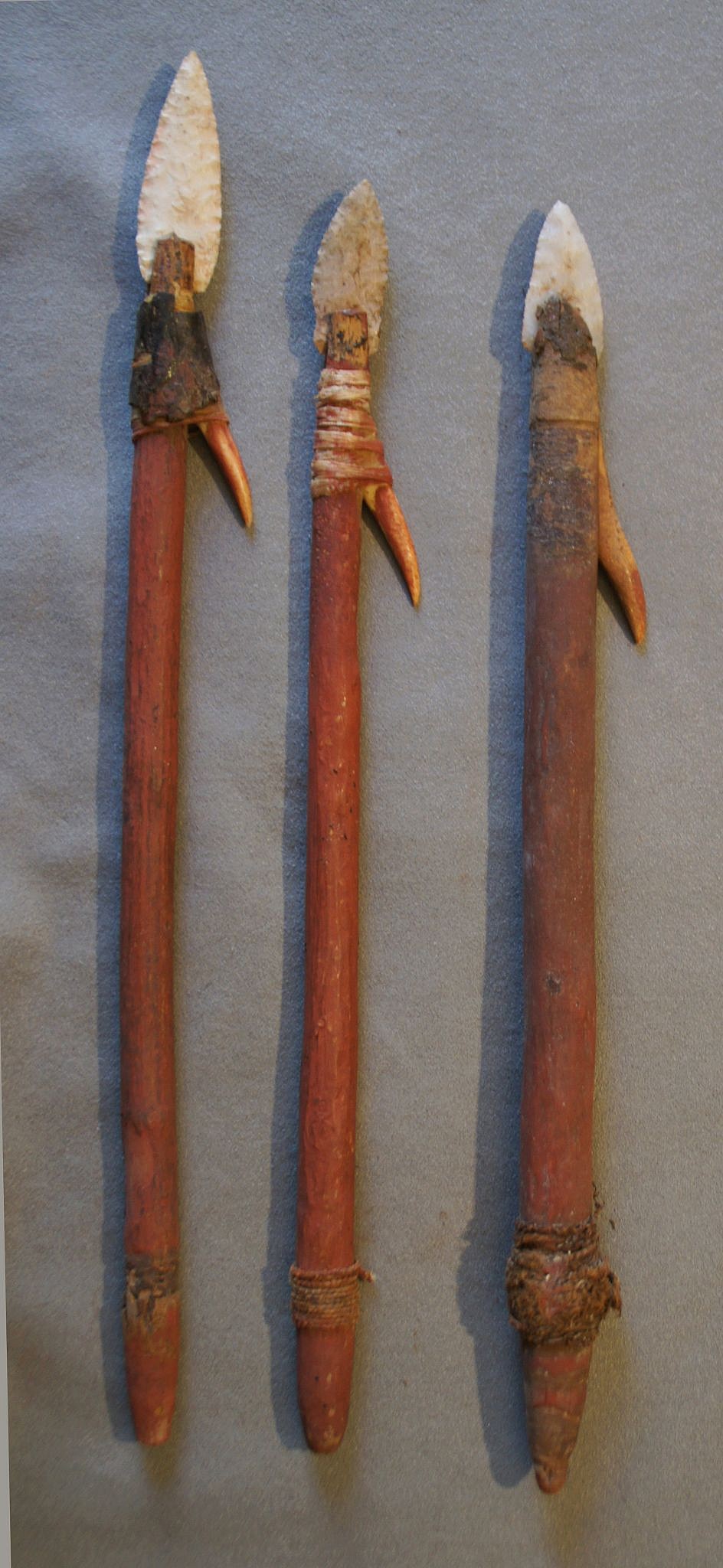




Chile, Three Early Seal Harpoons with Oval Stone Points, Bone Barbs and Wood Shafts
These harpoons have a slit at one end of a wood shaft, to which a napped point is attached and secured with wrapped string and tree resin. The opposite end of the shaft was carved to a tapered point that fit into the socket of the harpoon thrower. This size harpoon was used to capture seals, which were used for food, fat, and skins.
Period: Chile, Camaroni, North Coast, c. 100 - 600 BC
Media: Wood
Dimensions: Length: 9"-10"
n6028
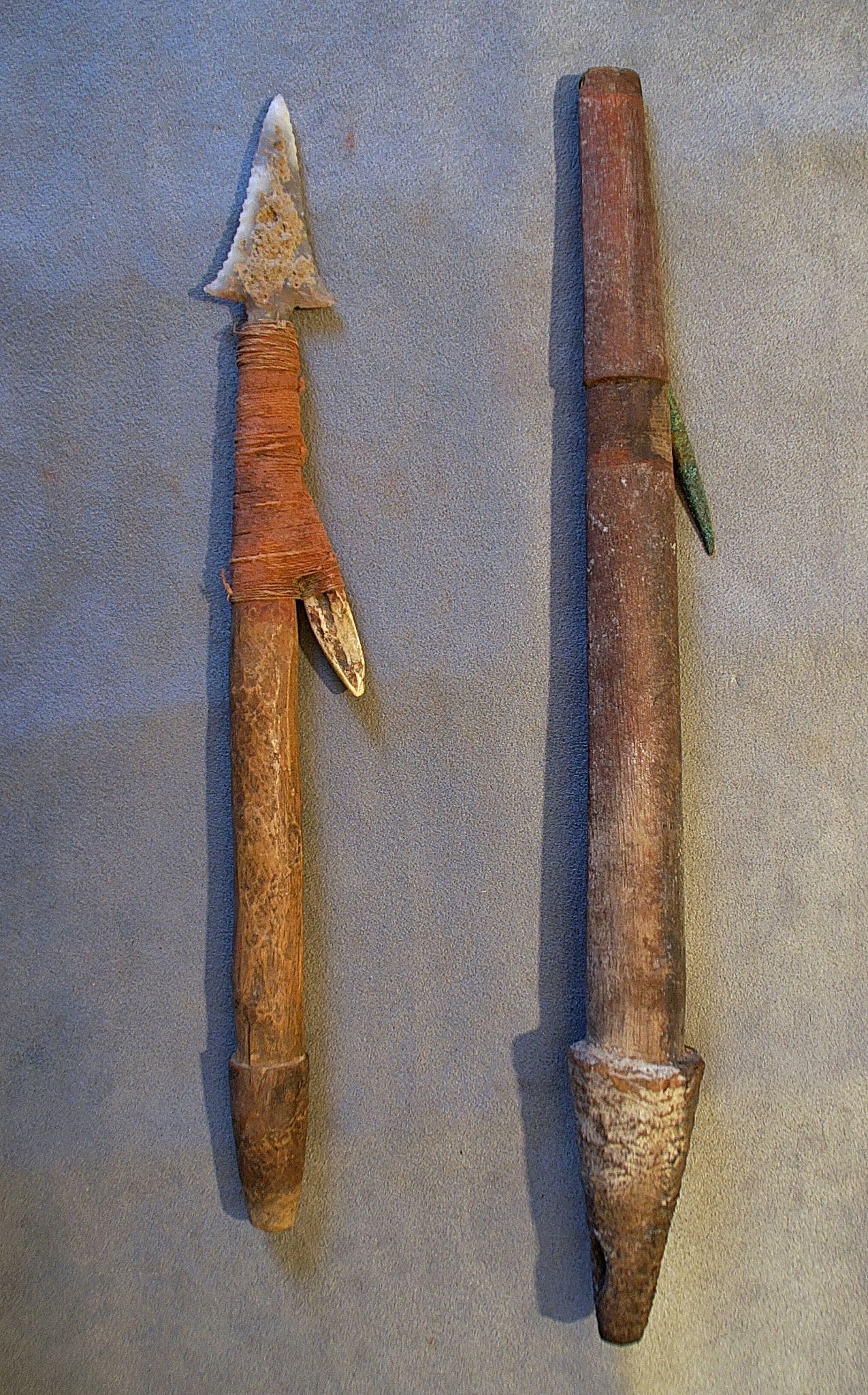
Chile, Two Harpoon Forepoints with Bone and Copper Barb
These harpoons were used for hunting for sea lion. The barbs are set into a carved notch and lashed with cotton thread. The other end is tapered to fit into a harpoon pole. The copper barb was used for hunting larger animals.
Period: Chile, Arica, Gentilar phase, c. AD 1200 - 1470
Media: Wood
Dimensions: Lengths: 12" & 16"
n6035
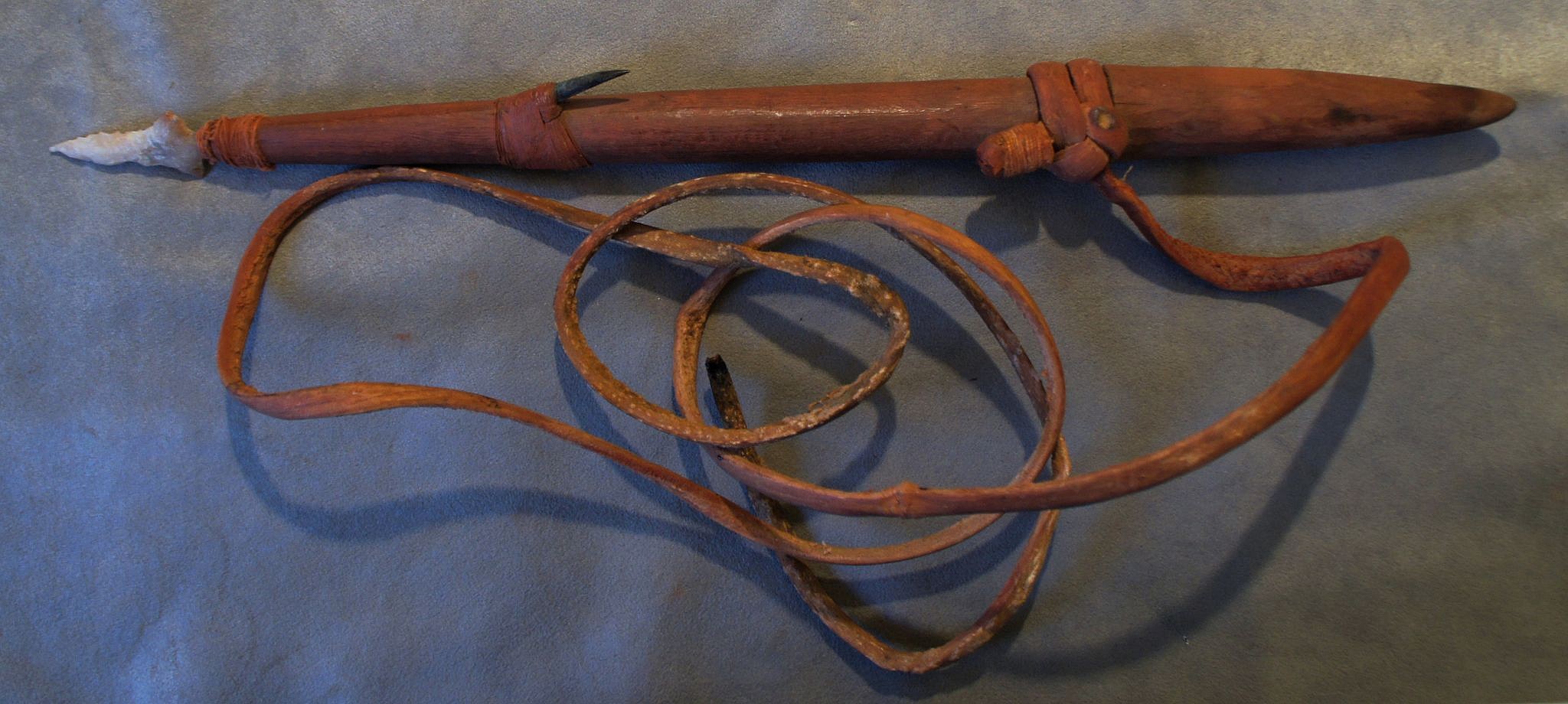


Chile, Large Whaling Harpoon Forepiece with Stone Point, Copper Barb, and Original Leather Line
The harpoon shaft is maded of carved hardwood with a hole for the knapped stone point, and tapered socketed end. The leather line is wrapped and knotted around a grooved band to prevent the line from sliding off. The barb is copper and lashed into a groove.
Media: Wood
Dimensions: Harpoon: 18.5"; Line: approx 4.5"
n6040
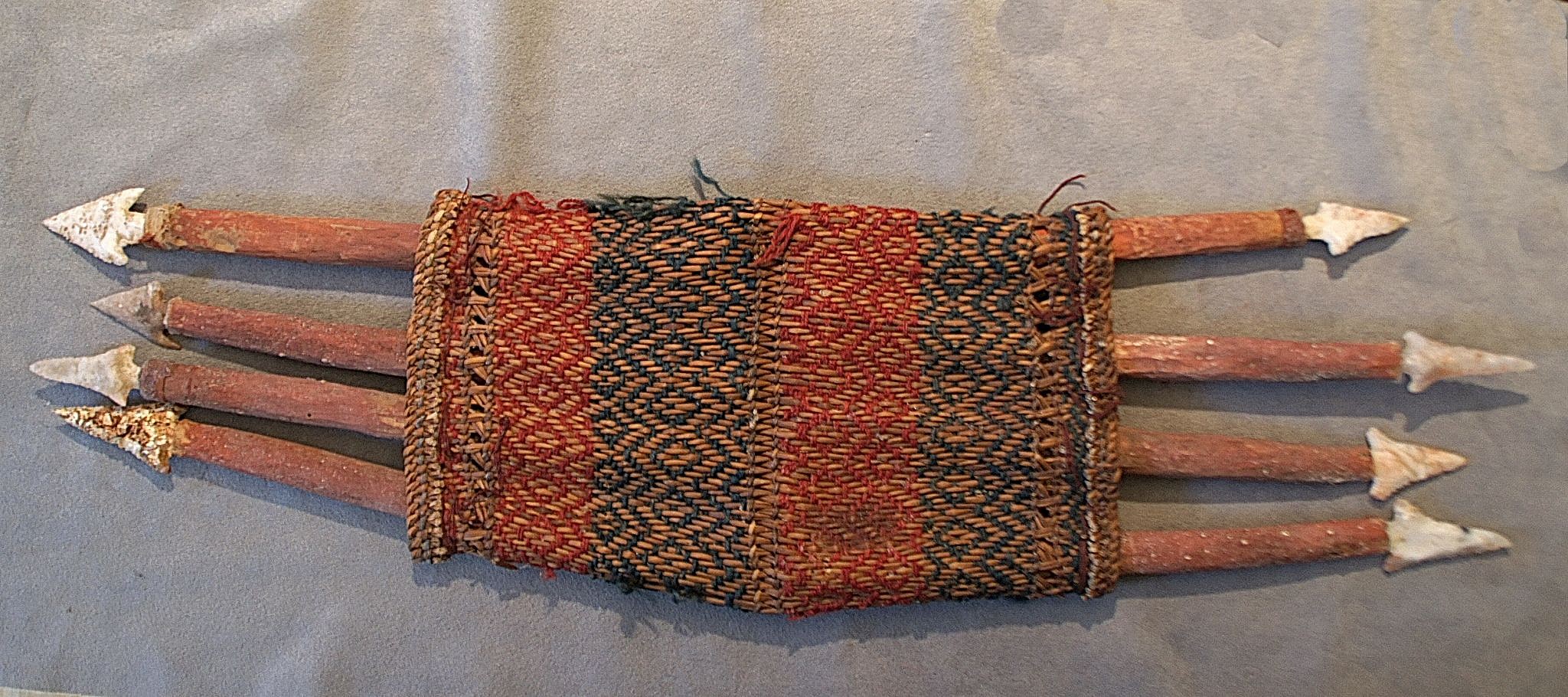
Chile, Arica Harpoon Quiver With Eight Harpoons
This decorative fiber quiver is woven with dyed red and green reeds, and is intact with its original wood harpoon points and napped stone arrows. The wood harpoon points would have been set into a longer throwing stick; the point releases when the harpoon is retrieved. The quiver, also known as a porta harpoon (harpoon carrier) holds eight points. It was used by the fisherman to hold ammunition on extended fishing trips. Junius Bird describes and illustrates these porta harpoons in "EXCAVATIONS IN NORTHERN CHILE," 1943, pg. 223. The harpoons are painted red, which was ceremonial and indicates that they were probably for the afterlife
Period: Chile, Arica, formative period, c. 1000 BC - AD 300
Media: Wood
Dimensions: Length: 23" Width: 7"
n6041
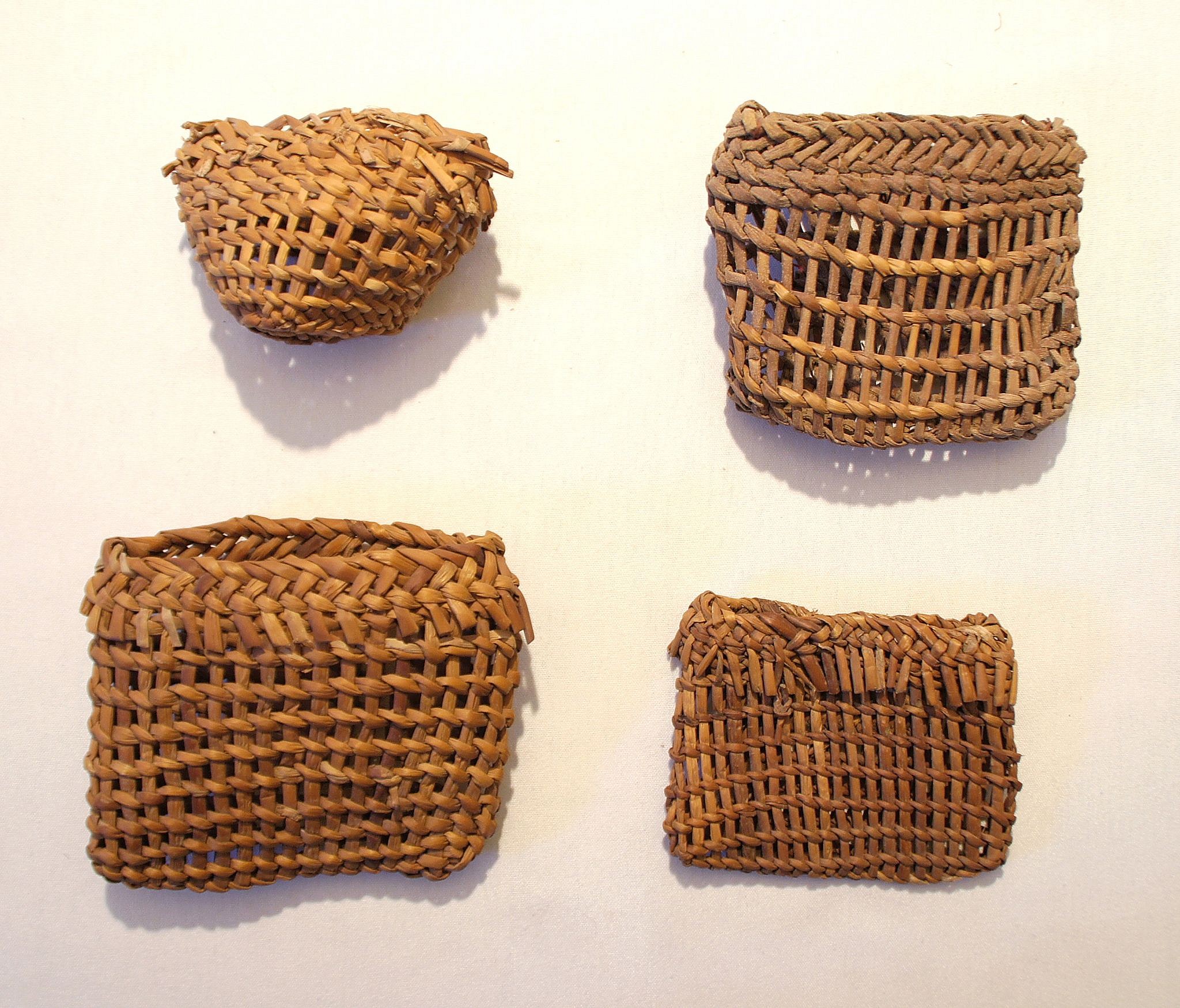


Chile, Eight Twined Baskets For Fishing Line and Hooks
These small baskets made of tule reed were decorated with different patterns. The baskets were just big enough to hold a hook, line and sinker. It is possible that all four baskets were made by the same maker.
Period: Chile, Arica, formative period, c. 1000 BC - AD 300
Media: Wood
Dimensions: Height: 1.25" - 1.75"
N6025
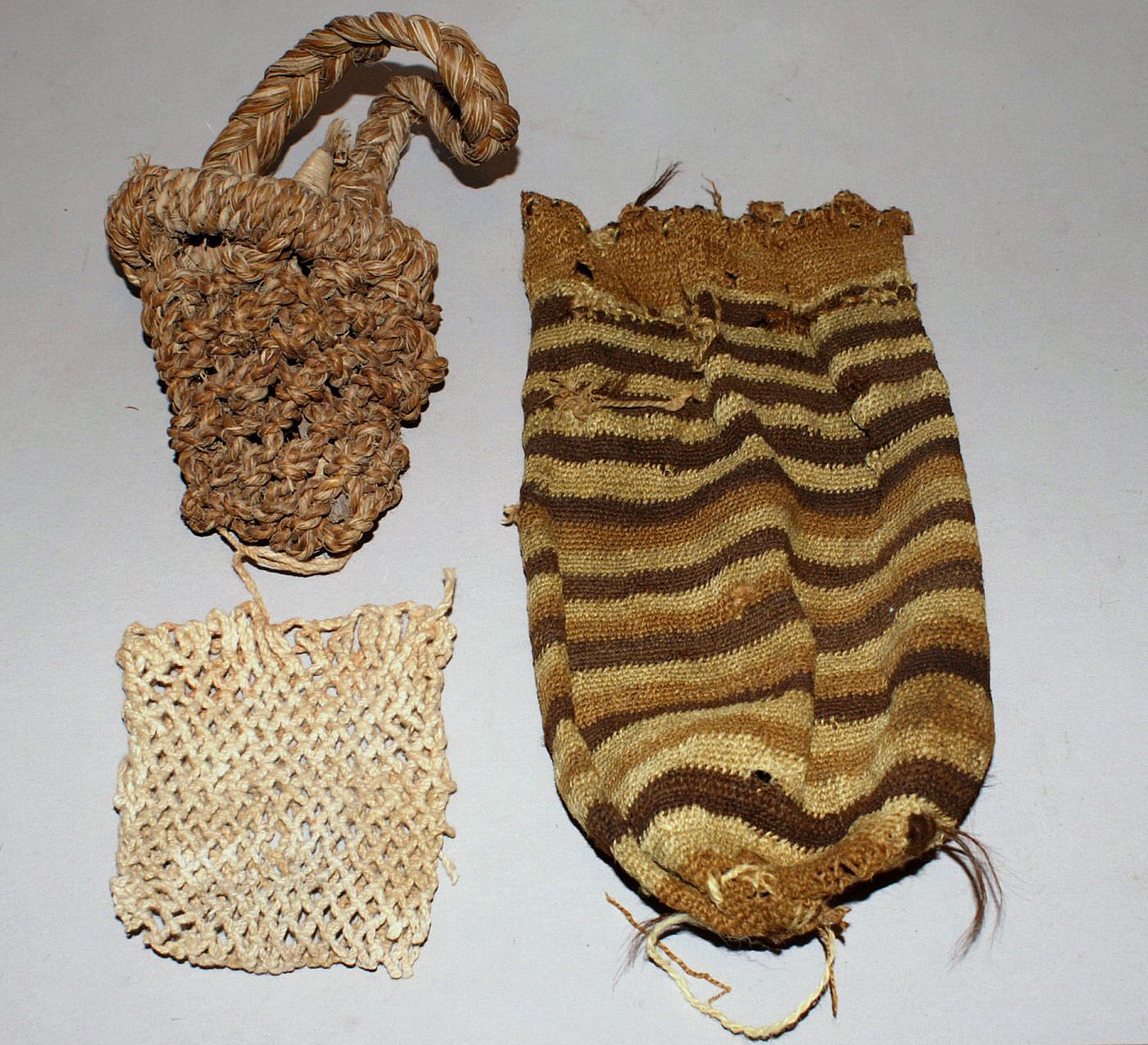
Chile, Three Types of Bags used by Fisherman
The bag with the handle is made of hemp, and would have been used for storing tools. The white cotton bag was used to store bait for small fish. The striped bag was made of wool with a draw string on top and a mesh on the bottom. This bag would have been used for holding small fish. Each bag was made with a different weaving technique.
Period: Chile, Arica, Early formative period, Alta Ramirez, c. AD 600 - 900
Media: Textile
Dimensions: Lengths vary: 3"-8"
n6045
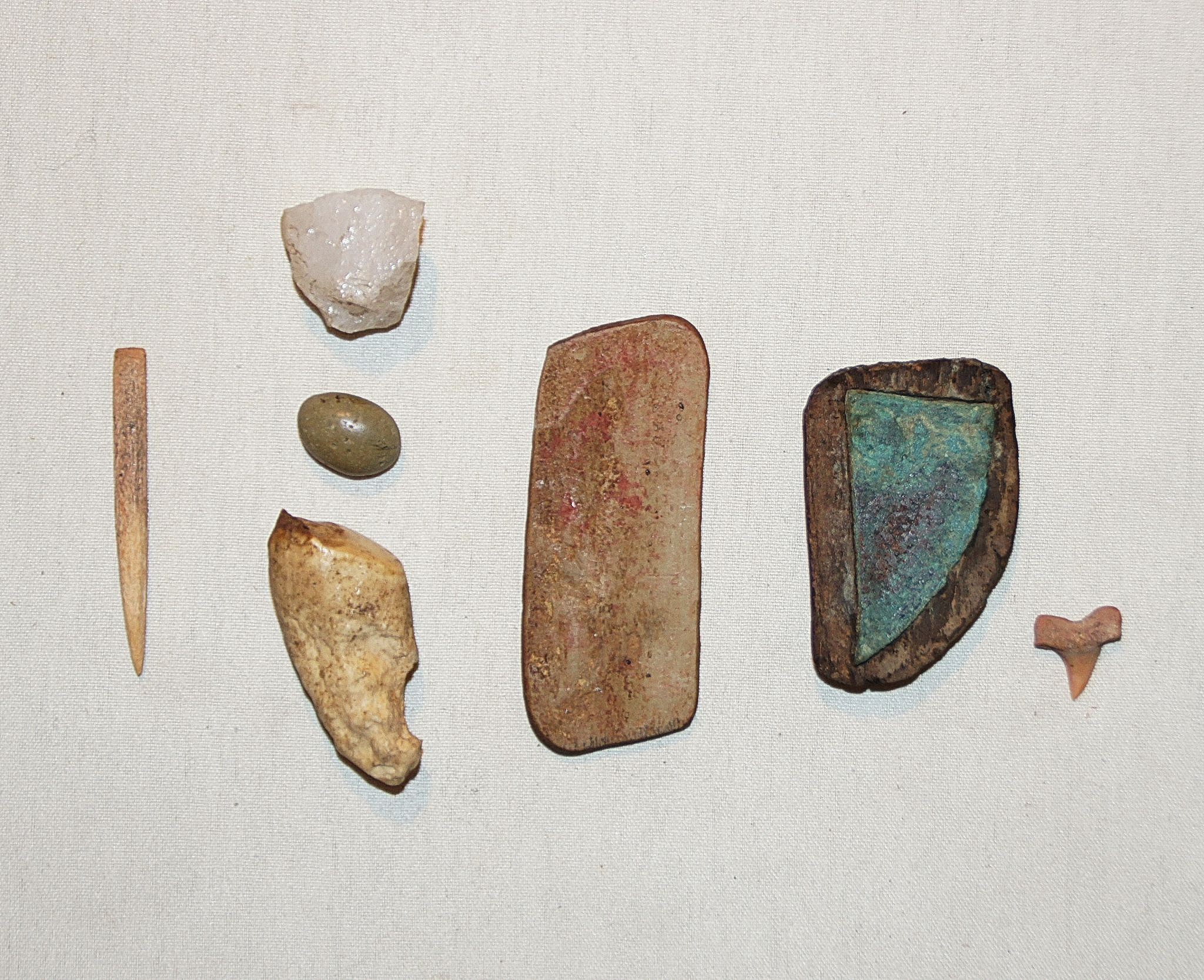


Chile, Tools for Chipping and Cutting with Copper Blade in Wood Case
These tools were found in a fisherman's burial. The set inclueds: a bone awl for marking, a bone napping stone for arrow heads, a smooth green stone for hammering, a stone crystal for sharpening copper hooks, a flat rectangular stone for sharpening hooks, a copper blade in its wood case and a small sharks tooth for inscribing.
Period: Chile, Arica, formative period, c. 1000 BC - AD 300
Media: Stone
Dimensions: Length 1. 8â€
N6015
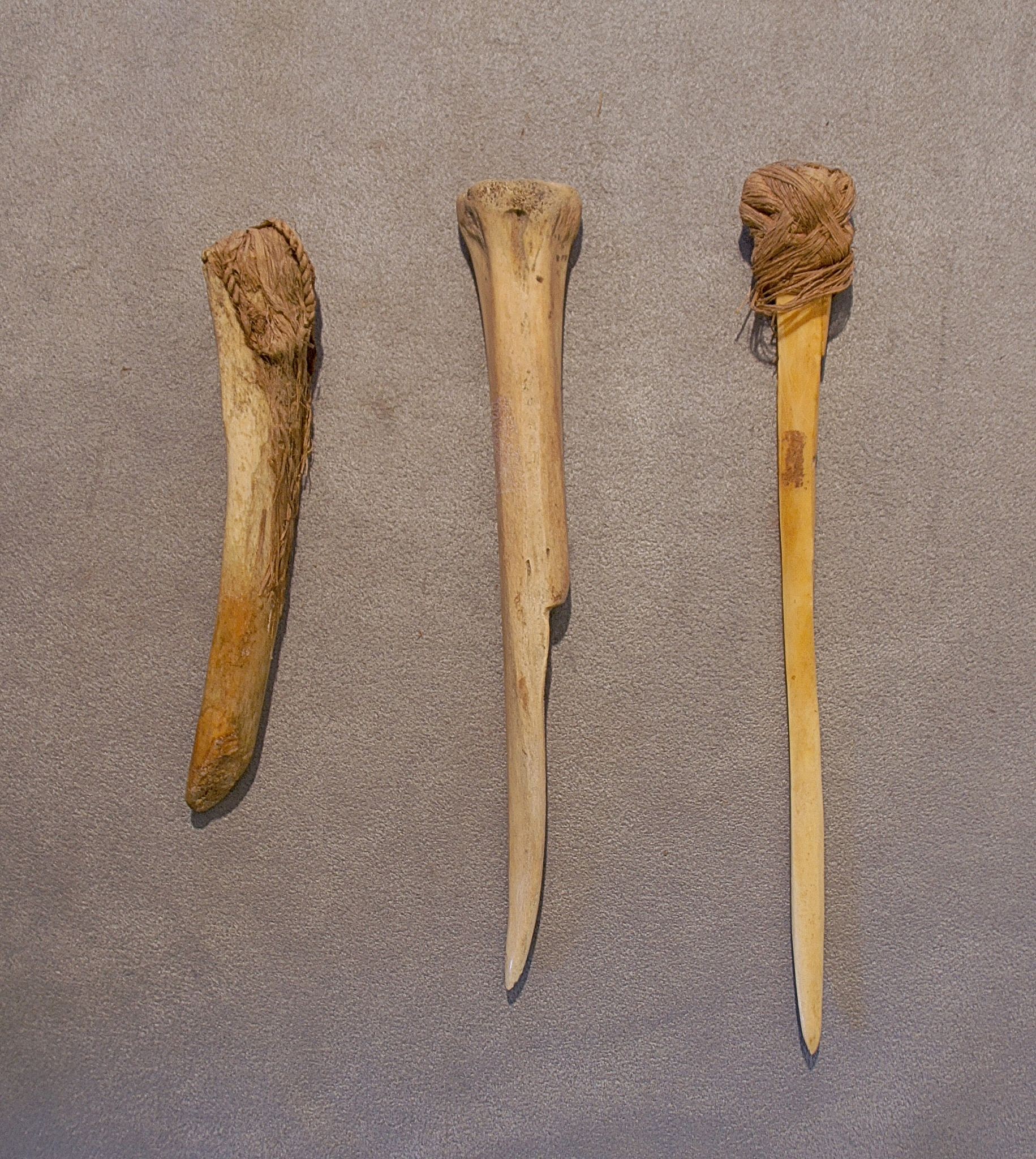


Chile, Three Bone Tools for Chipping and Opening Clam Shells
These tools were made from sea lion ribs. The shorter one was used for chipping stone points. The two longer ones were used for opening clams and mussels. The hemp wrapped end was to protect the hand when opening shells.
Period: Chile, Azapa, North Coast, c. AD 900 - 1500
Media: Bone
Dimensions: Lengths Vary: 5.75" - 8"
n6032
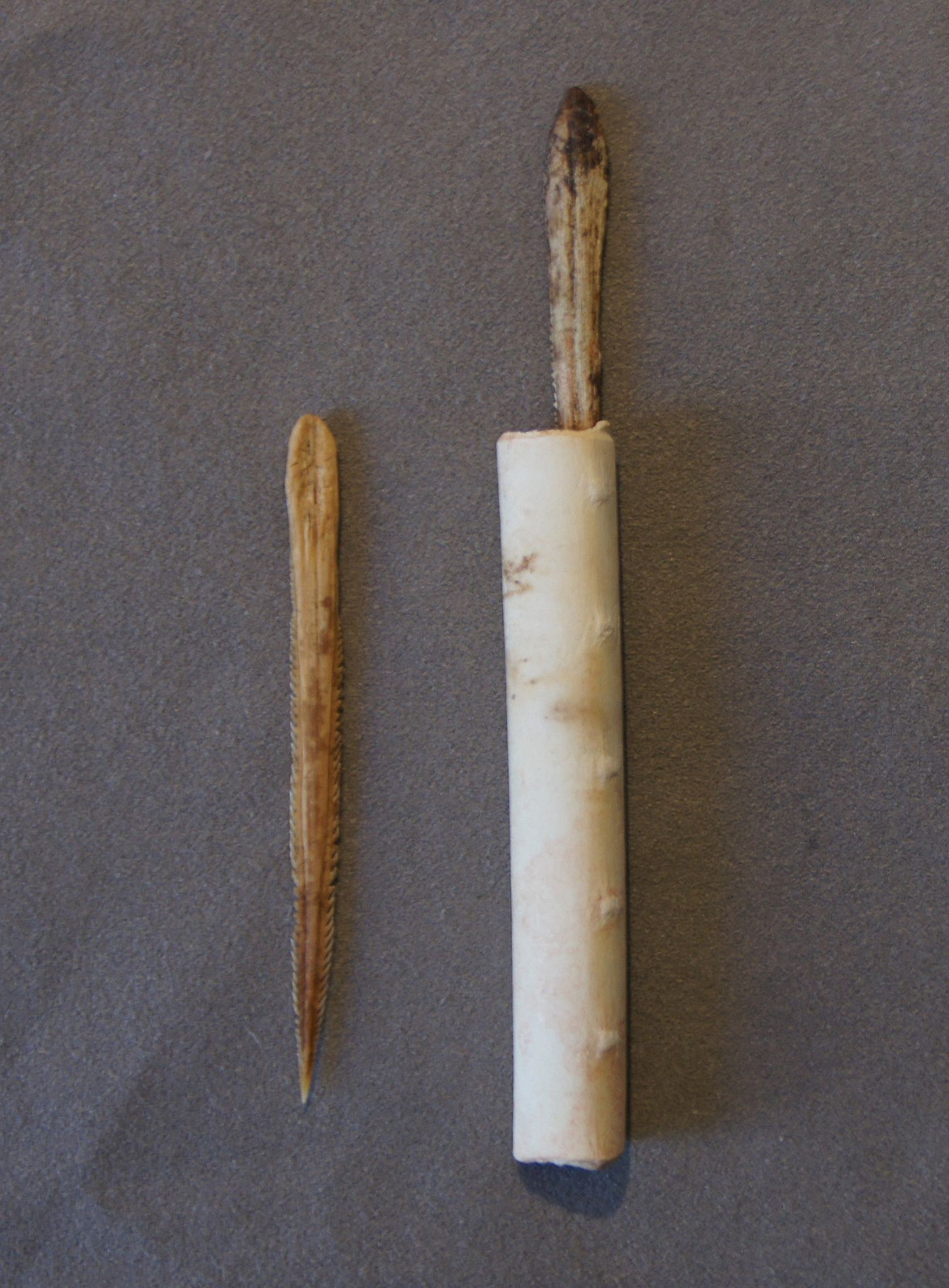


Chile, Two Stingray Stingers with Bone Container
These bone stingray stingers were used for fine cutting of fish or seal meat.
Period: Chile, Cabuza phase, c. AD 300 - 700
Media: Bone
Dimensions: Length: 3"
n6026
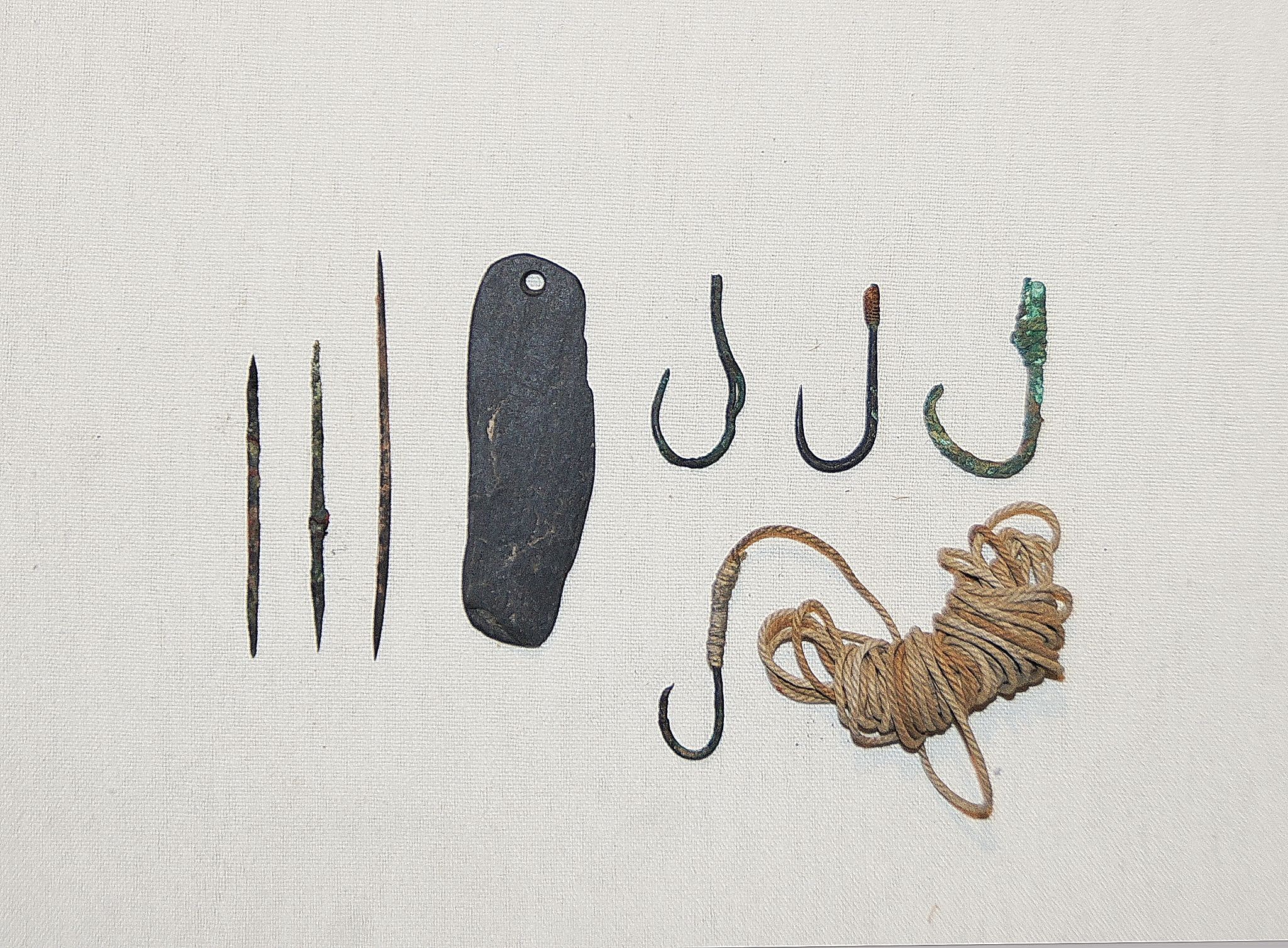
Chile, Copper Fish Hooks and Copper Needles for Spearing, with Sharpening Stone
A small copper hook is attached to its original cotton line. Three of the hooks have traces of cotton line still attached. The copper needles were used for spears. The flat stone was used to sharpen the hooks and the needles.
Period: Chile, Arica, formative period, c. 1000 BC - AD 300
Media: Metal
Dimensions: Length: 1†– 2.5â€
N6022
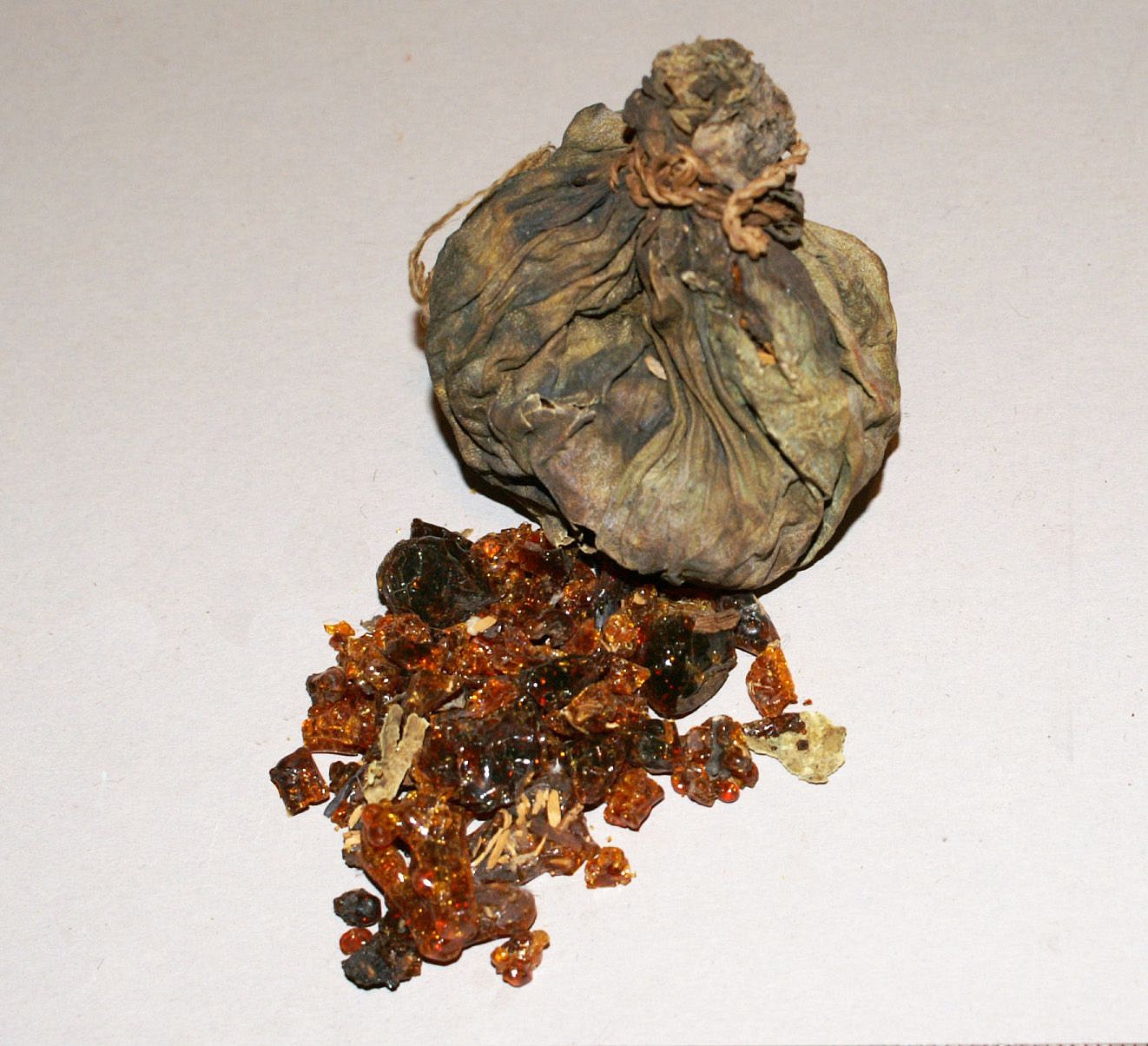
Chile, Pelican Beak Leather Pouch Filled with Tree Resin Crystals
The Pelican's lower beak is called a gular pouch. Tree resin, when heated, becomes a water-proof bond.
Period: Chile, Arica, Far North Coast, c. AD 900 - 1200
Media: Other
Dimensions: Diameter: Approx. 4"
n6042
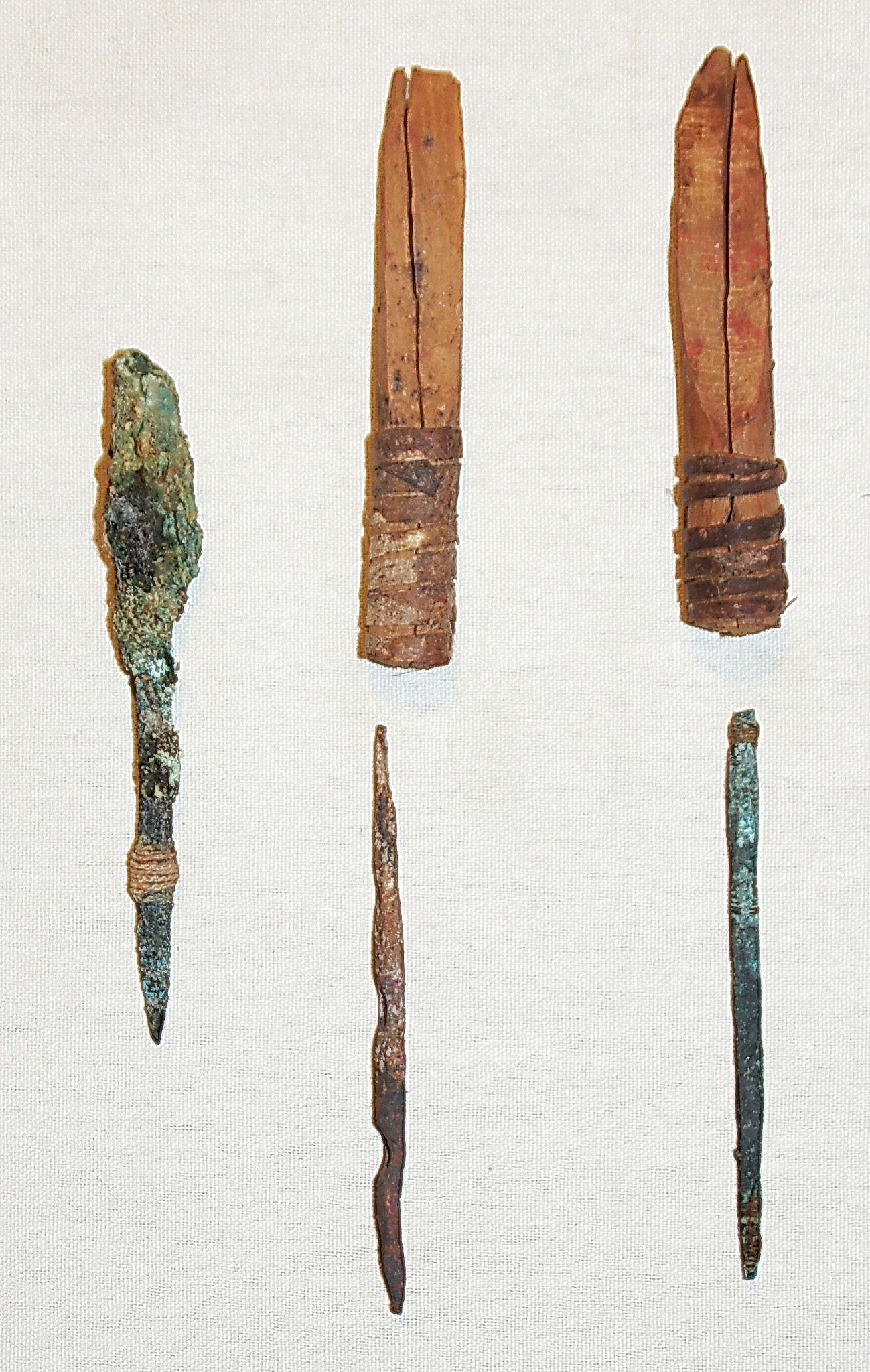



Chile, Three Copper Drill Bits and Two Wood Drill Chucks
Wood drill chucks were split lengthwise and cut on a bevel, the wrapped with together with gut. A copper drill bit was inserted into the chuck and tightened gut. The beveled end was attached to a beveled wooden shaft and worked with a bow drill.
Period: Chile, Cabuza phase, c. AD 300 - 700
Media: Wood
Dimensions: Length: 2.5"
n6027
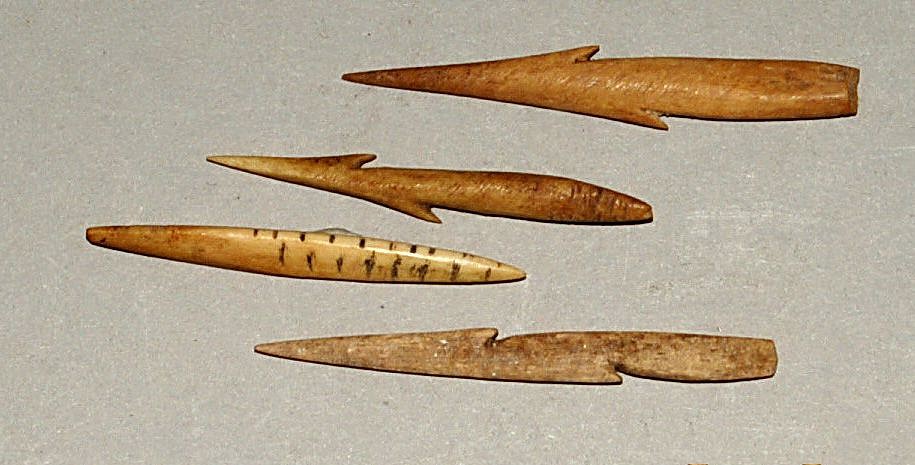



Chile, Three Carved Bone Barbs with Measuring Tool
These barbs were lashed to a cigar-shaped stone sinker. The measuring tool was marked with lines and dots on the edge. These markings allowed the maker to carve the spikes in the same place on each barb .
Period: Chile, Arica, Far North Coast, c. AD 900 - 1200
Media: Bone
Dimensions: Length: 2"
n6044
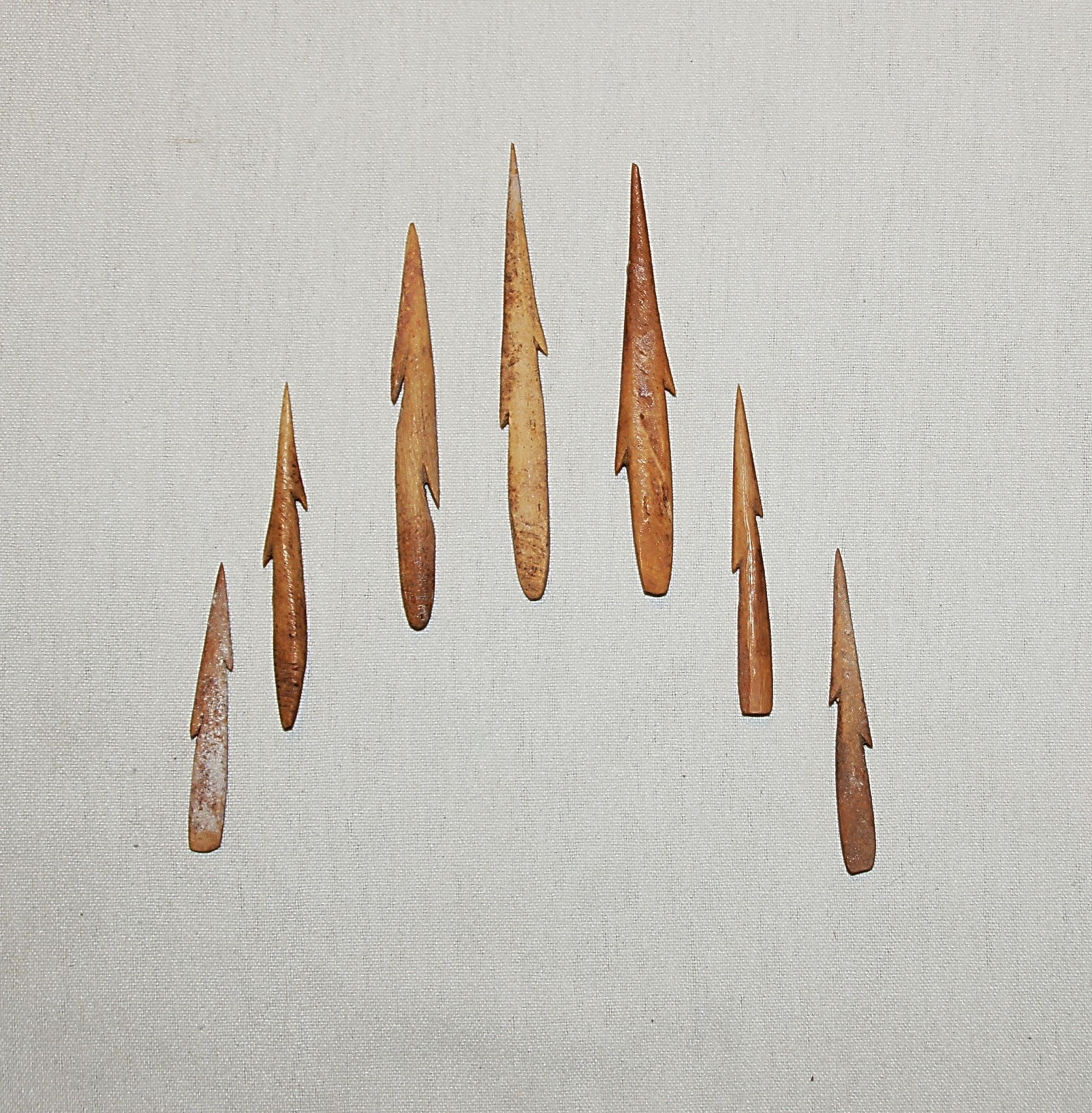
Chile, 7 Bone Carved Barbs for Harpoon
These barbs were fitted to small slender wooden shafts to spear fish.
Period: Chile, Arica, formative period, c. 1000 BC - AD 300
Media: Bone
Dimensions: Length: 2†– 3.5â€
N6020
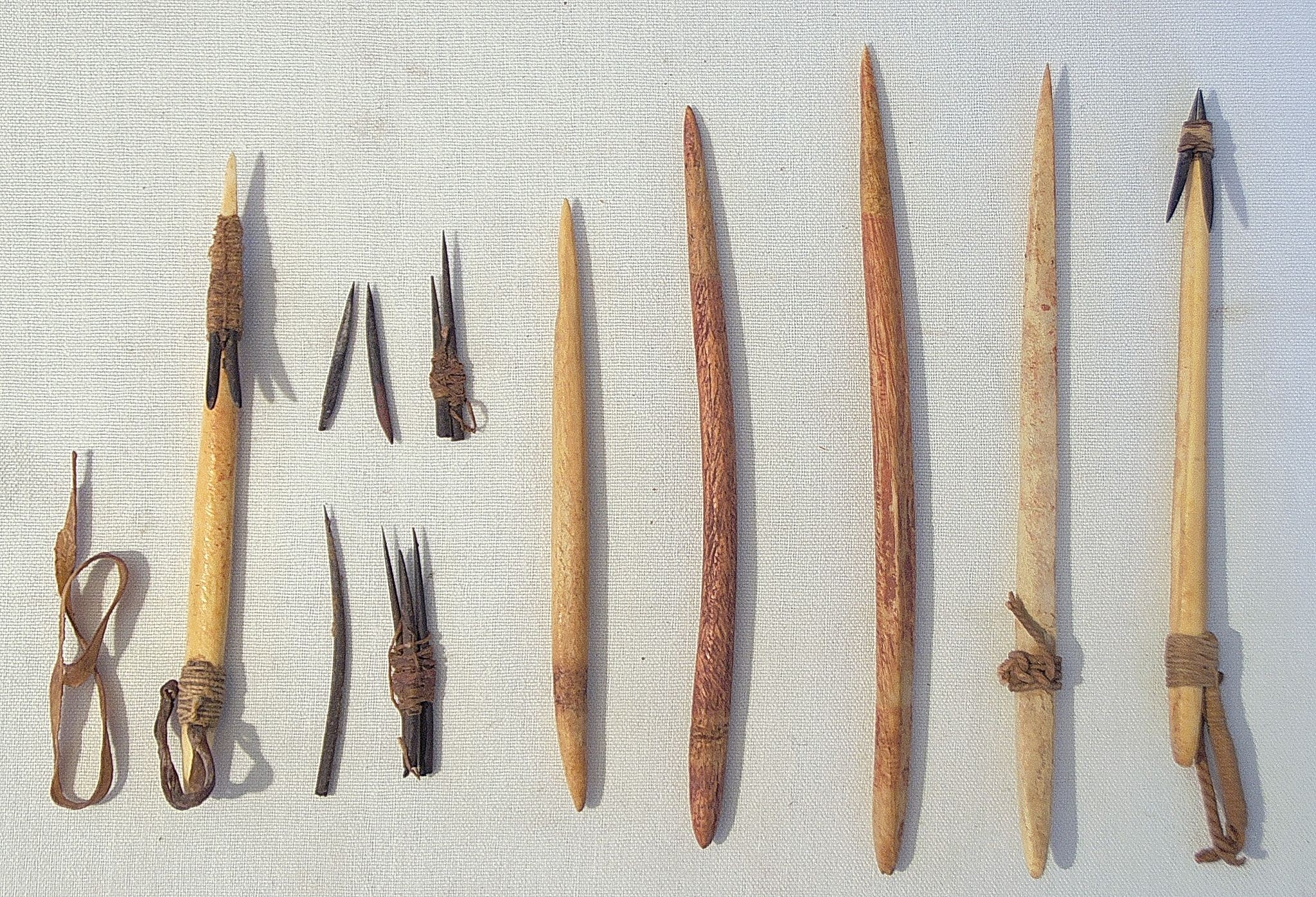
Chile, Bone and Thorn Harpoon Forepieces as Works in Progress
Carved bones, cactus thorns, and gut were prepared to make harpoon forepieces for spearing small fish and birds. The thorns were attached to a bone tip with cotton thread. The gut was used for a recovery loop.
Period: Chile, Arica, formative period, c. 1000 BC - AD 300
Media: Wood
Dimensions: Lengths vary: 1†– 5â€
N6023
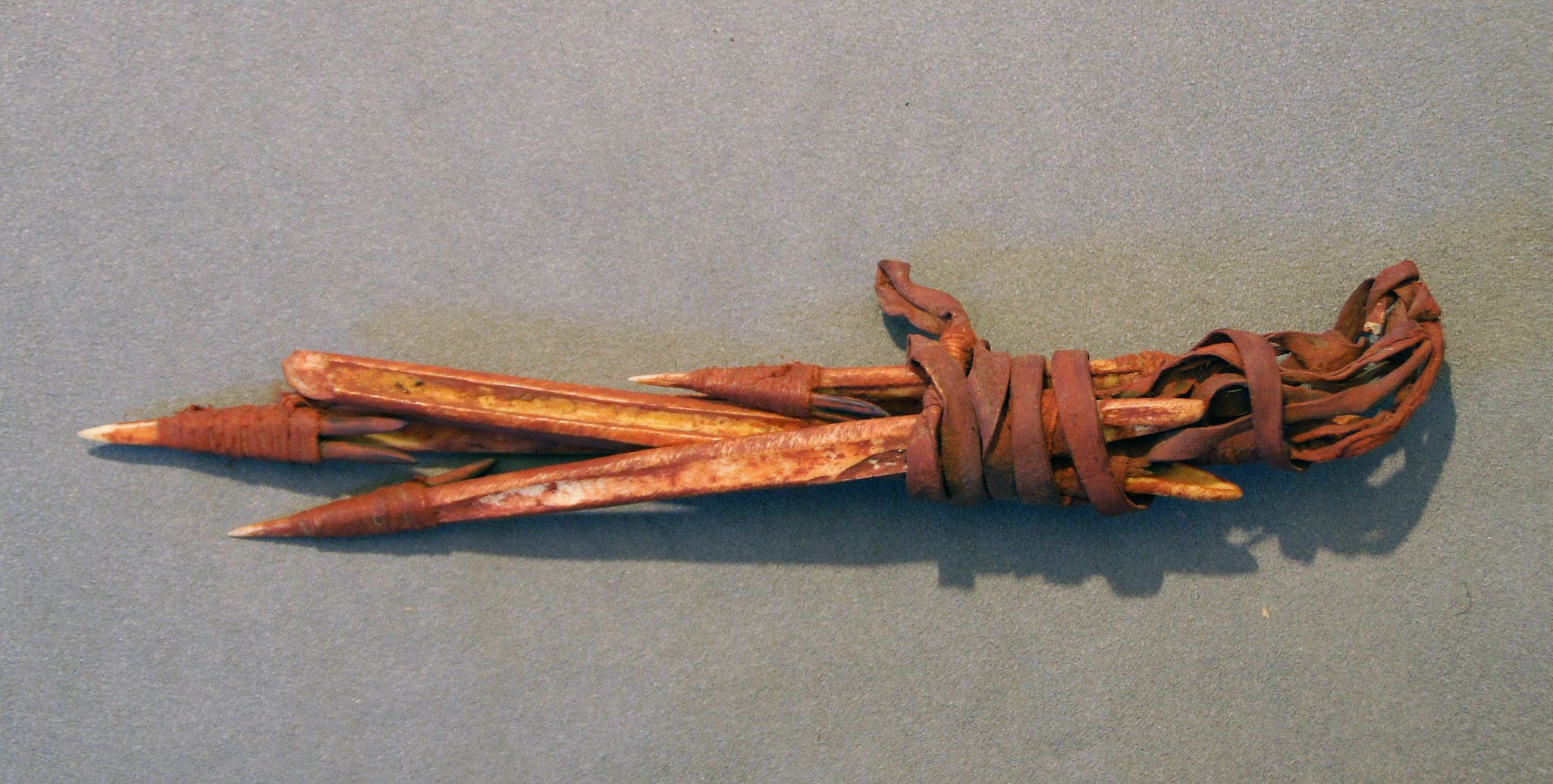


Chile, Four Bone and Thorn Harpoon Forepoints Lashed Together with Leather
Small harpoon forepoints covered in red pigment and lashed with leather. This bundle was buried for the afterlife and was probably a fisherman's set.
Period: Chile, Arica, formative period, c. 1000 BC - AD 1100
Media: Bone
Dimensions: Length: 8"
n6039
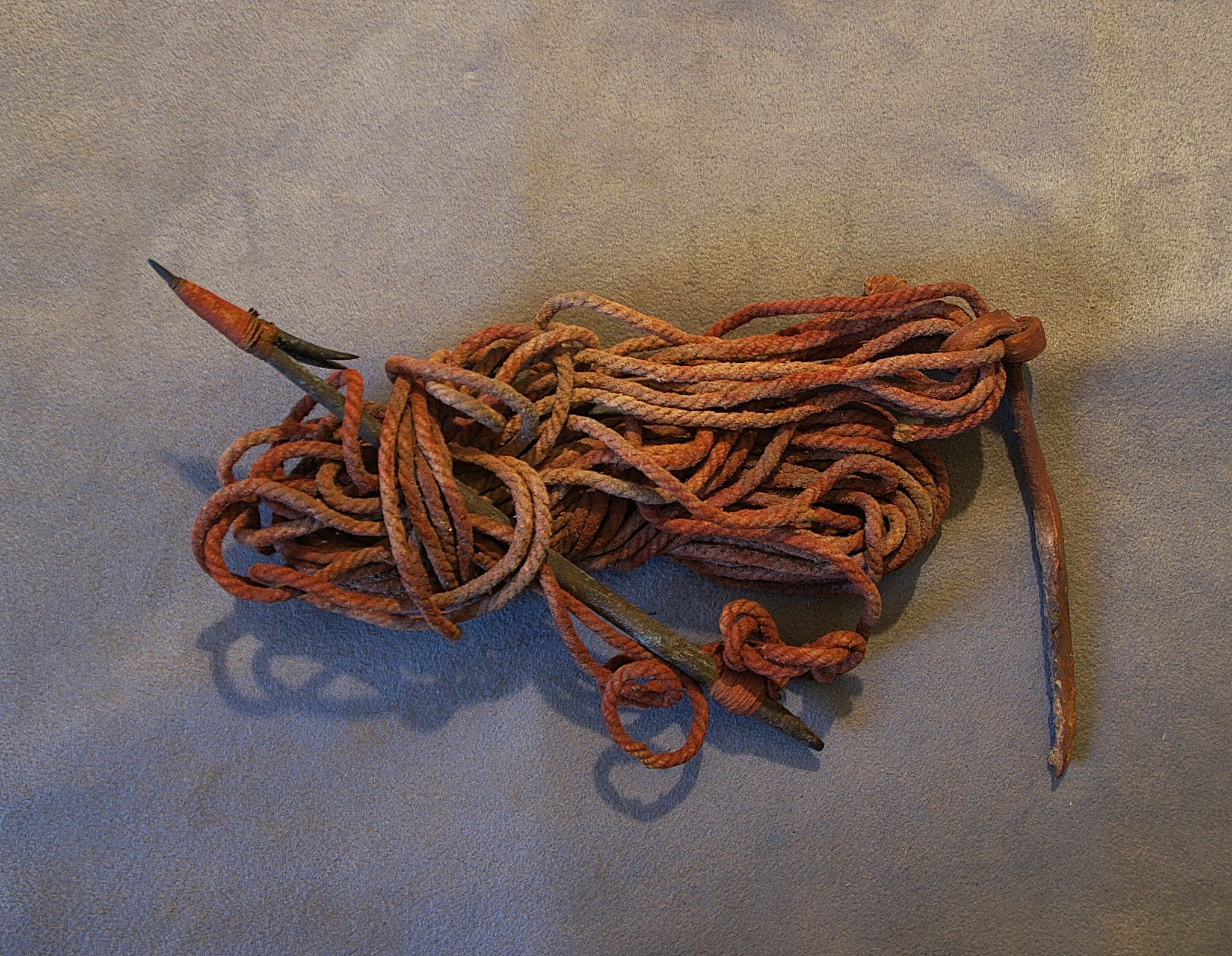


Chile, Harpoon Forepoint with Original Cotton Cord
Small harpoon with its original three-ply spun cotton retrival cord. The harpoon point has a barb made of two short thorns lashed to the shaft. The harpoons still shows signs of red paint, which indicates that it was intended for burial.
Media: Textile
Dimensions: Length of cord: approx. 26"
n6038
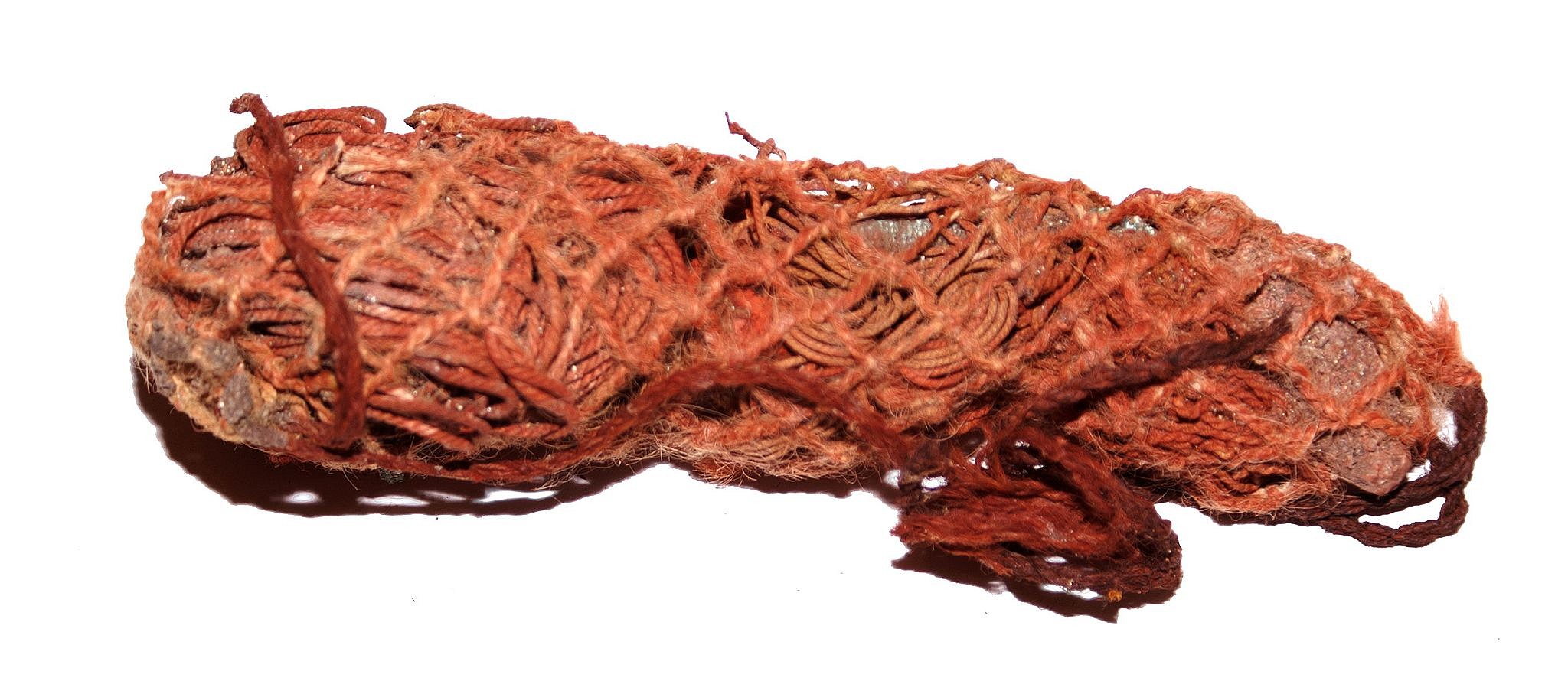


Chile, Fishermans' Kit for the Afterlife
This fisherman's kit has two lines of twined cotton, a stone sinker, and copper hooks, all of which have fused together with age. The kit has been dyed red, indicating that it was for the afterlife.
Period: Chile, Arica, Far North Coast, c. AD 900 - 1200
Media: Textile
Dimensions: Length: 6"
n6043

